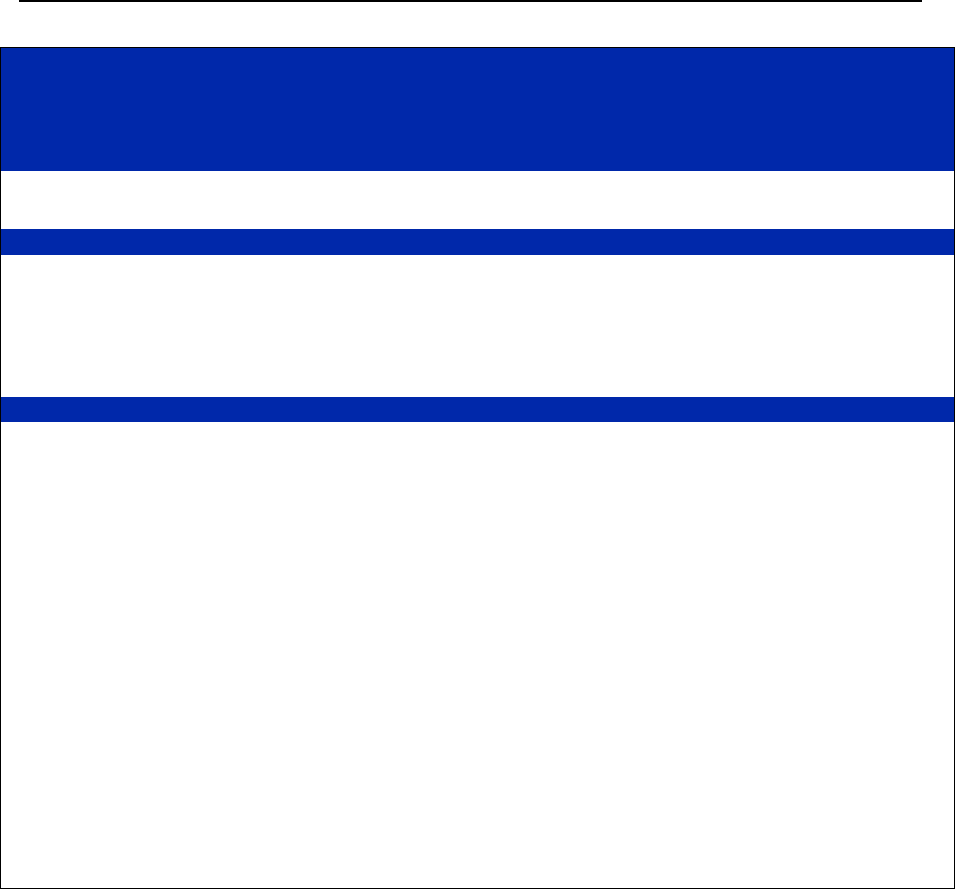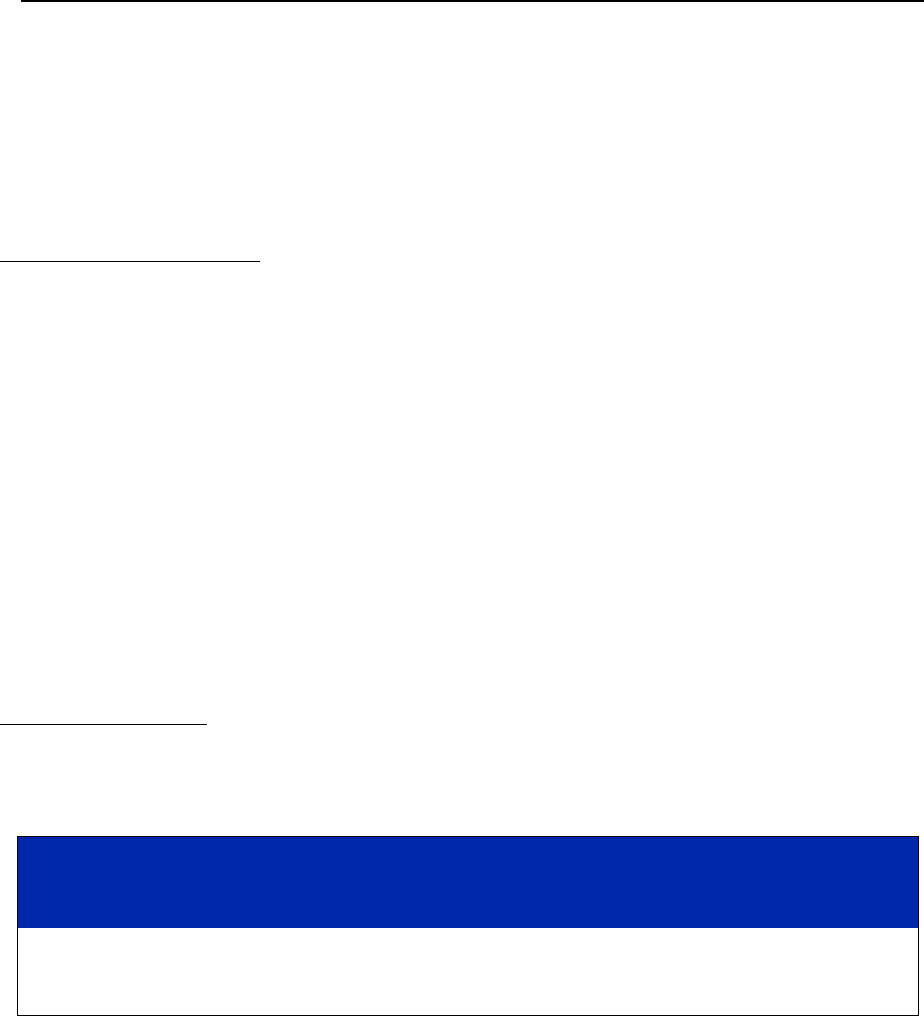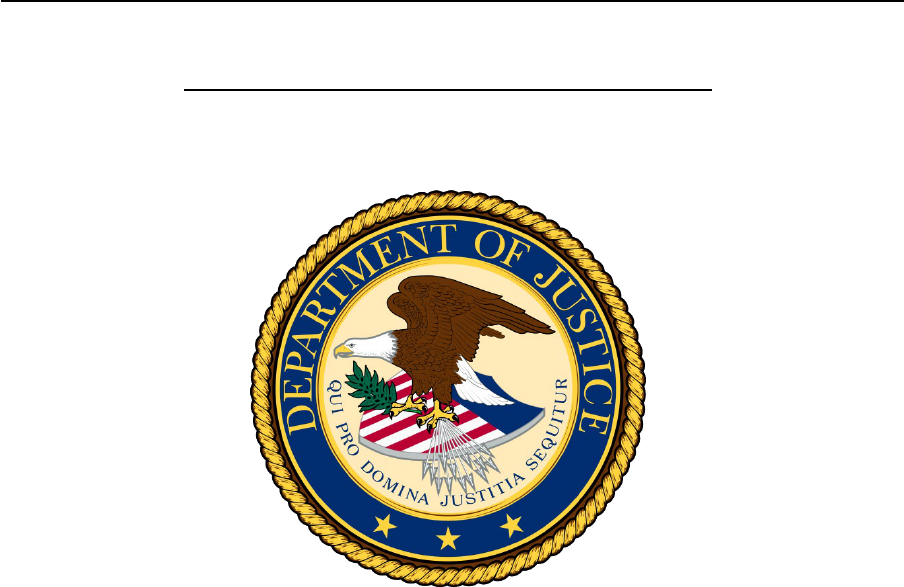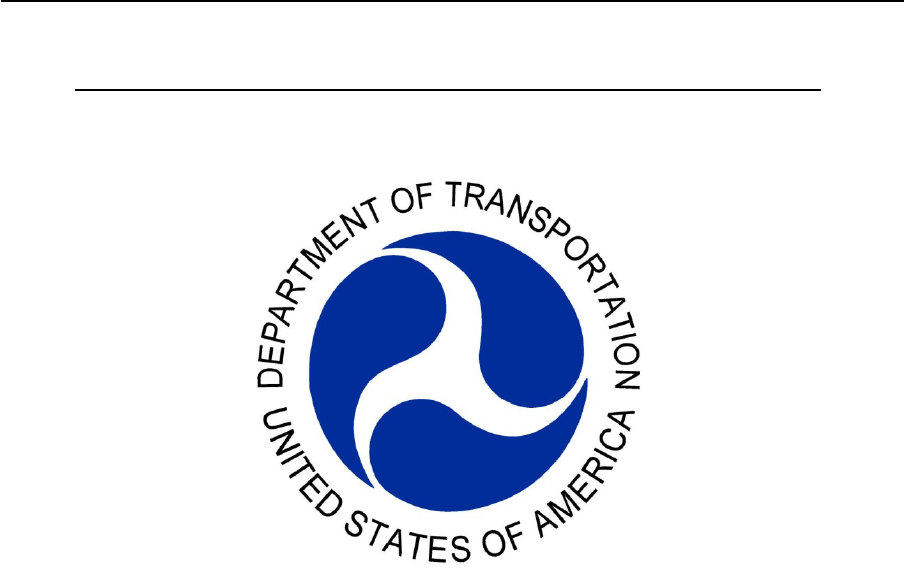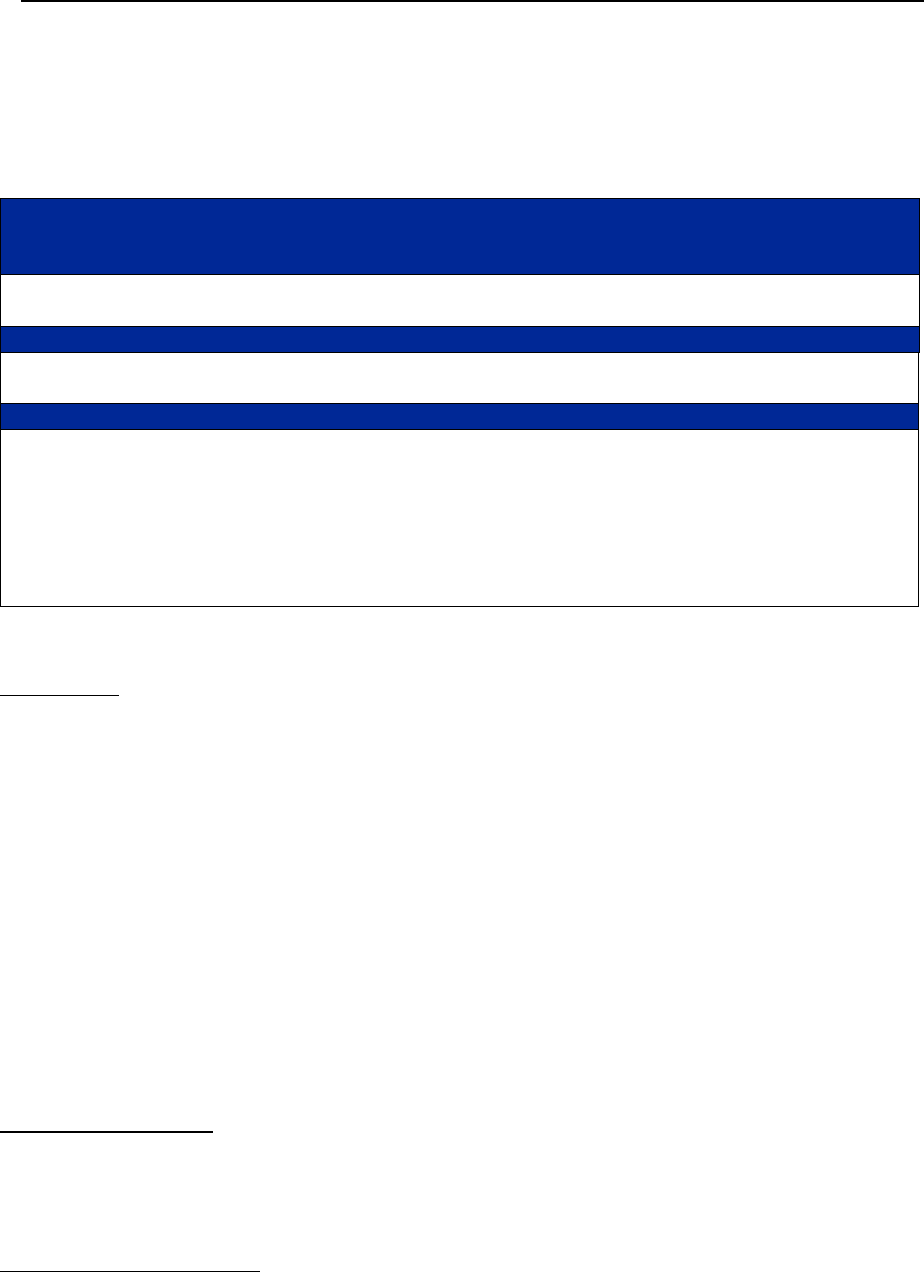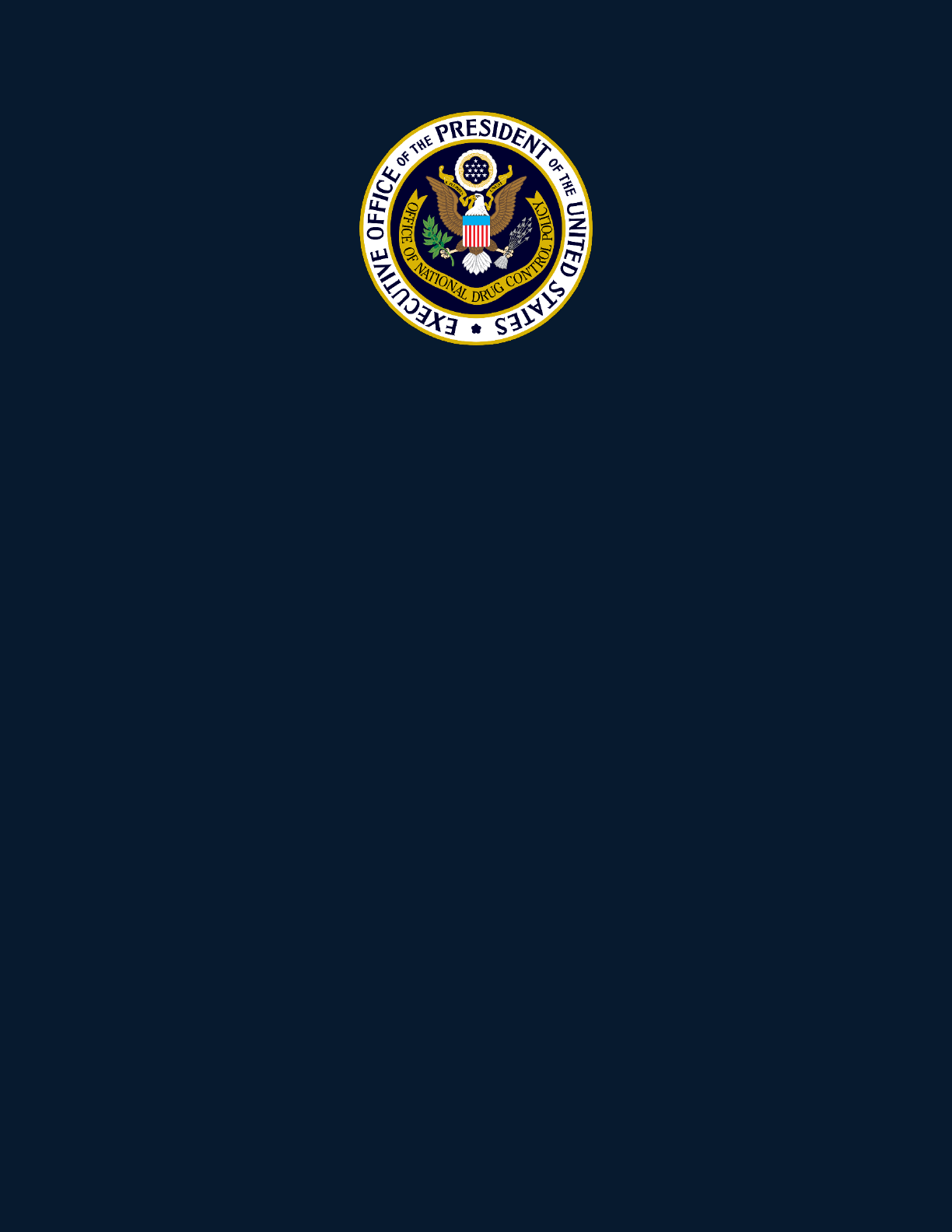
NATIONAL
DRUG CONTROL
STRATEGY
FY 2022
Budget and Performance
Summary
Office of National Drug Control Policy
JULY 2021

NATIONAL DRUG CONTROL STRATEGY: FY 2022 BUDGET AND PERFORMANCE SUMMARY
1
National Drug Control Strategy:
FY 2022 Budget and Performance Summary
Table of Contents
Executive Summary ............................................................................................................................ 4
Agency Budget Summaries ................................................................................................................ 22
AMERICORPS ........................................................................................................................................................ 23
DEPARTMENT OF AGRICULTURE ......................................................................................................................... 29
United States Forest Service .................................................................................................. 30
Office of Rural Development .................................................................................................. 35
COURT SERVICES AND OFFENDER SUPERVISION AGENCY FOR THE DISTRICT OF COLUMBIA ......................... 38
DEPARTMENT OF DEFENSE ................................................................................................................................. 52
Office of the Secretary of Defense .......................................................................................... 53
Defense Security Cooperation Agency .................................................................................... 60
Defense Health Program ........................................................................................................ 65
DEPARTMENT OF EDUCATION ............................................................................................................................. 67
Office of Elementary and Secondary Education ....................................................................... 68
FEDERAL JUDICIARY............................................................................................................................................. 72
DEPARTMENT OF HEALTH AND HUMAN SERVICES ............................................................................................. 77
Administration for Children and Families ................................................................................ 78
Centers for Disease Control and Prevention ............................................................................ 81
Centers for Medicare & Medicaid Services ............................................................................... 87
Food and Drug Administration ............................................................................................... 92
Health Resources and Services Administration ........................................................................ 97
Indian Health Service .......................................................................................................... 101
National Institutes of Health ................................................................................................ 104
Substance Abuse and Mental Health Services Administration ................................................. 119
DEPARTMENT OF HOMELAND SECURITY .......................................................................................................... 133
Customs and Border Protection ........................................................................................... 134
Federal Emergency Management Agency .............................................................................. 144
Federal Law Enforcement Training Centers ........................................................................... 146
Immigration and Customs Enforcement ................................................................................ 149
Science and Technology Directorate ..................................................................................... 158
United States Coast Guard ................................................................................................... 161

NATIONAL DRUG CONTROL STRATEGY: FY 2022 BUDGET AND PERFORMANCE SUMMARY
2
DEPARTMENT OF HOUSING AND URBAN DEVELOPMENT ................................................................................ 166
Office of Community Planning and Development ................................................................... 167
DEPARTMENT OF THE INTERIOR ....................................................................................................................... 170
Bureau of Indian Affairs ....................................................................................................... 171
Bureau of Land Management ................................................................................................. 175
National Park Service .......................................................................................................... 178
DEPARTMENT OF JUSTICE................................................................................................................................. 181
Asset Forfeiture Program..................................................................................................... 182
Bureau of Alcohol, Tobacco, Firearms, and Explosives ........................................................... 185
Bureau of Prisons ................................................................................................................ 188
Criminal Division ................................................................................................................ 194
Drug Enforcement Administration ........................................................................................ 197
Federal Bureau of Investigation ........................................................................................... 204
Office of Justice Programs ................................................................................................... 207
Organized Crime Drug Enforcement Task Forces ................................................................... 217
United States Attorneys ...................................................................................................... 222
United States Marshals Service ............................................................................................ 225
DEPARTMENT OF LABOR ................................................................................................................................... 230
Employment and Training Administration ............................................................................ 231
Office of Workers’ Compensation Programs .......................................................................... 236
Office of Inspector General .................................................................................................. 239
OFFICE OF NATIONAL DRUG CONTROL POLICY ................................................................................................ 241
High Intensity Drug Trafficking Areas ................................................................................... 242
Other Federal Drug Control Programs ................................................................................... 245
Salaries and Expenses ......................................................................................................... 248
DEPARTMENT OF STATE .................................................................................................................................... 251
Bureau of International Narcotics and Law Enforcement Affairs ............................................. 252
United States Agency for International Development ............................................................. 274
DEPARTMENT OF TRANSPORTATION ................................................................................................................ 279
Federal Aviation Administration ........................................................................................... 280
National Highway Traffic Safety Administration .................................................................... 287
DEPARTMENT OF THE TREASURY ...................................................................................................................... 292
Financial Crimes Enforcement Network ................................................................................ 293
Internal Revenue Service ..................................................................................................... 295
Office of Foreign Assets Control ........................................................................................... 300

NATIONAL DRUG CONTROL STRATEGY: FY 2022 BUDGET AND PERFORMANCE SUMMARY
3
UNITED STATES POSTAL SERVICE ..................................................................................................................... 303
United States Postal Inspection Service ................................................................................ 304
DEPARTMENT OF VETERANS AFFAIRS ............................................................................................................... 308
Veterans Health Administration ........................................................................................... 309
APPENDICES ................................................................................................................................... 323
ACRONYMS ......................................................................................................................................................... 324
NATIONAL DRUG CONTROL BUDGET ACCOUNT STRUCTURE .......................................................................... 332
PROGRAM LEVEL FUNDING ................................................................................................................................ 336

NATIONAL DRUG CONTROL STRATEGY: FY 2022 BUDGET AND PERFORMANCE SUMMARY
4
Executive Summary
President Biden has made clear that addressing addiction and the overdose epidemic is an urgent
priority for his Administration. Overdose rates have been increasing for several years, and the COVID-19
pandemic has exacerbated the situation. For too many people with substance use disorders (SUD), the
pandemic has reduced access to critical prevention, treatment, harm reduction, and recovery services,
increased isolation, and led to the loss of employment opportunities. There were almost 92,000
overdose deaths predicted for the 12-month period ending in October 2020 according to Centers for
Disease Control and Prevention (CDC) provisional data.
In order to curb this epidemic, the President’s 2022 Budget supports implementation of the Biden-
Harris Administration’s Drug Policy Priorities for Year One through a historic $41.0 billion investment for
National Drug Control Program agencies, a $669.9 million increase over the FY 2021 enacted level. The
largest increases in funding are requested to support access to critical public health interventions like
treatment and prevention services. With these increases, the Budget Request devotes an historically
high 57.3 percent of drug control resources to demand reduction programs and activities like evidence-
based treatment, harm reduction, prevention, and recovery services.
Even as Congress reviews the Fiscal Year 2022 Budget described below, a significant down payment has
already been made to address the epidemic. The American Rescue Plan, which President Biden signed
into law in March 2021, appropriated nearly $4 billion to enable the Department of Health and Human
Services’ (HHS) Substance Abuse and Mental Health Services Administration (SAMHSA) and the Health
Resources and Services Administration (HRSA) to expand access to vital mental health and SUD
services. This funding is just the start of the Biden-Harris Administration’s historic commitment to
ensure that the federal government promotes evidence-based public health and public safety actions
to address this epidemic. Throughout this work, the Administration will prioritize advancing racial
equity in our Nation’s approach to drug policy, including by improving access to culturally competent
behavioral health services and improving the health and long-term outcomes of people with SUDs
through treatment rather than incarceration. Every possible means will be used to reduce overdose
deaths over the next months and years.
The President’s FY 2022 Budget for drug related programs and initiatives builds on the American Rescue
Plan’s resources to curb the overdose epidemic. The Administration’s historic investment of $10.7
billion in discretionary funding in HHS includes support for research, prevention, treatment, harm
reduction, and recovery support services, with targeted investments to meet the needs of populations
at greatest risk for overdose and SUD. Similarly, the Administration is making critical investments to
reduce the supply of illicit substances in the United States. This includes increases for efforts to
interdict illicit drugs and disrupt international drug trafficking networks, and in domestic law
enforcement efforts to enhance cooperation between federal, State, local, and Tribal law enforcement
agencies.
This document focuses on investments by the 18 National Drug Control Program Agencies (NDCPA), but
we recognize that making progress requires collaboration among federal, State, local, and Tribal
communities across the country. We appreciate the contributions of the Nation’s burdened SUD
workforce. Although financial resources cannot solve this crisis entirely, we hope that this increased

NATIONAL DRUG CONTROL STRATEGY: FY 2022 BUDGET AND PERFORMANCE SUMMARY
5
level of support enables the dedicated prevention, treatment, recovery, and harm reduction workforce
to reach more Americans impacted by this epidemic.
Immediately below are descriptions of some of the programs and activities, by Department, that
support the President’s drug control policy priorities. Following that information, detailed data on
overall spending is provided, with tables focusing on prevention, treatment, domestic law
enforcement, interdiction, and international efforts. Following that functional breakdown is a
summary table providing historical trends in spending.
Department of Agriculture
• The U.S. Department of Agriculture (USDA) is requesting a total of $11.4 million in FY 2022 for its
efforts at their office of Rural Development (RD). USDA’s request includes funding for infrastructure
projects that will help meet the needs of people with SUDs in rural communities, such as
telemedicine networks and brick-and-mortar treatment facilities.
• RD funds are provided to help rural communities by linking teachers and medical service providers
in one area to students and patients in another.
• The FY 2022 USDA request includes $10.7 million for the U.S. Forest Service (USFS) to continue
efforts to keep the national forests free of dangerous drug operations. The USFS works to identify,
investigate, disrupt, and dismantle drug trafficking organizations (DTO) involved in marijuana
cultivation, including supporting co-conspirators (transportation and financial components)
responsible for large-scale marijuana grow operations on National Forest System lands.
Department of Defense
• For FY 2022, the Department of Defense (DoD) is requesting $1.1 billion for its efforts. This funding
includes support for security cooperation efforts with partner nations, counterdrug operations,
detection and monitoring (D&M) efforts in support of drug interdiction operations, and funding for
the Defense Health Program (DHP).
Department of Education
• For FY 2022, the Department of Education is requesting $59.7 million to continue its ongoing
support for School Climate Transformation Grants, which provide resources for school-based
substance use prevention activities, as well as its technical assistance centers.
Department of Health and Human Services
• HHS continues to be a major provider of substance use prevention, treatment, and recovery
support services, as well as support to bolster the behavioral health infrastructure and capacity
building.
• SAMHSA is requesting $2.3 billion in FY 2022 for the SAMHSA State Opioid Response Grants, an
increase of $750.0 million over the FY 2021 enacted level. In addition, this grant program has a
permissible use to address methamphetamine and stimulant use disorder. These grants are
awarded to provide states, tribes, and U.S. territories with flexibility to address the specific
substance use related issues in an area.
• SAMHSA’s FY 2022 request also includes $3.5 billion for the Substance Abuse Prevention and
Treatment Block Grant, which includes a 10 percent set aside for recovery services and 20 percent

NATIONAL DRUG CONTROL STRATEGY: FY 2022 BUDGET AND PERFORMANCE SUMMARY
6
for evidence-based prevention activities. The Block Grant remains a critical source of funding for
states, tribes, and territories to provide prevention, treatment, and recovery services to
communities.
• At HRSA, $705.0 million in funding is requested in FY 2022 to support the SUD response in
community health centers and in rural America.
• At the CDC, $713.4 million is requested in FY 2022 to support continued nationwide surveillance and
data collection activities and other prevention-focused activities to address the misuse of
prescription medications.
• The Centers for Medicare and Medicaid Services (CMS) continue to be the largest funder of
treatment services in the National Drug Control Budget. For FY 2022, CMS anticipates increasing its
spending on addiction treatment to over $10.1 billion.
• The National Institute of Drug Abuse (NIDA) continues its world leading investment in drug-related
research. For FY 2022, NIDA requests $1.9 billion to support cutting edge research on all aspects of
addiction.
Department of Homeland Security
• The U.S. Coast Guard’s (USCG) FY 2022 request includes $2.0 billion for drug control activities. This
funding continues to support the construction of the fourth and long lead time parts for the fifth
Offshore Patrol Cutter and to develop technologies such as unmanned surface and subsurface
vessels for USCG counterdrug activities.
• Customs and Border Protection’s (CBP) FY2022 request of $3.1 billion will enable the agencies to
protect the Nation’s land, sea, and air borders by stemming the flow of illicit substances.
• Immigration and Customs Enforcement (ICE) is requesting $642.1 million in FY2022 for
counternarcotics (CN) efforts, including to investigate major drug trafficking and money laundering
cases.
• Science & Technology’s request of $6.3 million in FY 2022 will develop a layered set of solutions,
including detection hardware, fusion of sensor data, advanced analytics, and training, which can
be deployed rapidly within existing operational environments to support interdiction missions
within the mail and express consignment missions.

NATIONAL DRUG CONTROL STRATEGY: FY 2022 BUDGET AND PERFORMANCE SUMMARY
7
Department of Housing and Urban Development
• In FY 2022, the Department of Housing and Urban Development (HUD) is requesting $720.7 million
to fund its Continuum of Care program. The program provides funding for housing assistance to
people in need, including people in treatment for SUDs and people in recovery. This initiative seeks
to minimize the trauma and dislocation caused by homelessness and to optimize self-sufficiency
among individuals and families experiencing homelessness.
• HUD has also requested an additional $25.0 million to fund its Recovery Housing Program. This pilot
program helps communities provide stable, transitional housing for individuals in recovery from a
substance-use disorder.
Department of the Interior
• The Bureau of Indian Affairs’ FY 2022 request of $14.9 million to address the opioid epidemic on
Tribal lands through focused drug enforcement efforts, intelligence analysis and sharing, as well as
victim and witness support programs. In addition, BIA supports substance use prevention through
a School Resource Officer (SRO) program that provides instruction in drug awareness and gang
resistance using nationally recognized and adopted curricula for students.
• The Bureau of Land Management’s (BLM) FY 2022 request of $5.1 million for the identification,
investigation, disruption, and dismantling of illicit marijuana cultivation and smuggling activities
on public lands.
• In FY 2022, the National Park Service (NPS) is requesting $3.5 million to ensure that all pertinent
federal laws and regulations are enforced within park units. This includes funding for national parks
located along international borders to address problems such as drug trafficking with continued
cooperation with CBP and other federal, State and local agencies.
Department of Justice
• The FY 2022 request for the Department of Justice (DOJ) includes over $9.5 billion in resources for
investigations, prosecutions, state and local assistance, community programs, and intelligence
efforts to address drug control challenges, including the opioid epidemic.
• The Drug Enforcement Administration’s (DEA) FY 2022 request includes over $2.9 billion in support
of DEA’s mission to enforce the controlled substances laws and regulations of the United States.
The request focuses on disrupting and dismantling major Transnational Criminal Organizations
(TCO), coordinating drug investigations in foreign countries, and providing state and local
assistance.
• The Bureau of Prisons’ (BOP) FY 2022 request of $3.8 billion includes funding to support further
expansion of Medication-Assisted Treatment for incarcerated individuals with opioid use disorder,
in an effort to improve health outcomes and reduce recidivism.
• The Bureau of Alcohol, Tobacco, Firearms and Explosives (ATF) is requesting $41.2 million in FY 2022
to combat crime associated with arms trafficking and DTOs.
• The Federal Bureau of Investigation (FBI) is requesting $152.9 million in FY 2022 to support
initiatives that focus on identifying, targeting, disrupting, degrading, and dismantling TCOs.

NATIONAL DRUG CONTROL STRATEGY: FY 2022 BUDGET AND PERFORMANCE SUMMARY
8
• The Organized Crime Drug Enforcement Task Forces (OCDETF) request of $550.5 million in FY 2022
supports reducing the availability of illicit narcotics throughout the United States using a
prosecutor-led, multi-agency approach to combat TCOs.
• For FY 2022, the Office of Justice Programs (OJP) requests $631.9 million to support a range of
programs including the Comprehensive Opioid, Stimulant, and Substance Abuse Program; Drug
Courts; Veterans Treatment Courts; programs for youth; and the Residential Substance Abuse
Treatment Program. OJP grants provide flexibility to state, local, and tribal jurisdictions to address
substance use under all of its drug-related programs depending on local needs.
• The U.S. Marshals Service (USMS) FY 2022 request includes $1.1 billion for drug enforcement efforts
that center on capturing fugitives who have a nexus to the most serious drug trafficking and money
laundering organizations, as well as to those primarily responsible for the Nation’s illegal drug
supply. The USMS also directly contributes to the Administration’s supply reduction efforts by
maintaining the security of all in-custody prisoners with serious drug-related charges.
• The U.S. Attorneys Offices’ (USAO) FY 2022 request includes $98.9 million to support drug-related
investigations and prosecutions. A core mission of each of the USAOs is to prosecute high level
producers, suppliers, and traffickers for violations of federal drug laws to disrupt both international
and domestic DTOs and to deter continued illicit drug distribution and use in the United States. In
recent years, the USAOs have intensified their efforts to prosecute cases involving opioids, and
particularly synthetic opioids.
• The FY 2022 request for the Criminal Division (CRM) is $48.0 million for investigating and prosecuting
priority national and international drug trafficking and narcoterrorist groups.
Department of Labor
• The Department of Labor (DOL) is requesting $35.6 million in drug-related funding for FY 2022
through the Employment and Training Administration (ETA), the Office of Workers’ Compensation
Programs (OWCP), and its Office of Inspector General.
• In FY 2022, Job Corps is requesting $6.0 million to provide services to at-risk youth, including drug
prevention and drug education activities as related to job preparation.
• DOL is also requesting $20.0 million in competitive grants in FY 2022 to state workforce and labor
agencies and to Indian and Native American communities to address the economic and workforce
impacts associated with high rates of SUD.
Department of State
• The Department of State (DOS) is requesting a total $456.8 million in FY 2022 for drug-related
international programs for the Bureau of International Narcotics and Law Enforcement Affairs (INL)
and the U.S. Agency for International Development (USAID). This funding strengthens the rule of
law, human rights protections, law enforcement capacity, anti-corruption activities, and other
critical efforts around the globe, including in Mexico, Colombia, and Peru.

NATIONAL DRUG CONTROL STRATEGY: FY 2022 BUDGET AND PERFORMANCE SUMMARY
9
Department of Transportation
• The Department of Transportation (DOT) is requesting $47.1 million in FY 2022 for the Federal
Aviation Administration (FAA) and National Highway Traffic Safety Administration (NHTSA). These
funds include NHTSA’s continuing efforts to improve safety on our roads by addressing drugged
driving.
Department of the Treasury
• The FY 2022 request includes $63.1 million for the Department of the Treasury’s efforts to conduct
narcotics‐related financial investigations, address cybercrime, and interrupt the financial activities
of drug traffickers. The Department of the Treasury reports drug control funding for the Internal
Revenue Service’s (IRS) Criminal Investigation Division as well as the Financial Crimes Enforcement
Network (FinCEN) and the Office of Foreign Assets Control (OFAC).
Department of Veterans Affairs
• The Department of Veterans Affairs (VA) is requesting $922.0 million in FY 2022 to provide critical
SUD treatment services to our Nation’s Veterans.
AmeriCorps
• AmeriCorps is requesting $14.6 million in FY 2022 for drug-related activities. AmeriCorps has
prioritized efforts to address substance misuse and significantly increased its support for drug
prevention, education, and recovery programming in recent years.
Court Services and Offender Supervision Agency of the District of Columbia
• The FY 2022 request includes $67.5 million for the Court Services and Offender Supervision Agency
(CSOSA) for the District of Columbia to enhance public safety and reduce recidivism.
United States Postal Inspection Service
• In FY 2022, the United States Postal Inspection Service (USPIS) request includes $76.4 million for
drug control activities, including to investigate, arrest, and dismantle drug trafficking networks and
utilizes intelligence to effectively target and seize illicit substances nationwide. These efforts are a
critical part of efforts to interdict synthetic opioids and other illicit substances sent via international
mail.

NATIONAL DRUG CONTROL STRATEGY: FY 2022 BUDGET AND PERFORMANCE SUMMARY
10
FY 2022 Budget by Function
and Other Funding Priorities
The consolidated National Drug Control Budget details agency resources by function. Functions
categorize the activities of agencies into common drug control areas. NDCPAs are requesting a total of
$41.0 billion in drug control funding, an increase of $669.9 million over the FY 2021 enacted level. The
largest increases in funding are requested to support drug treatment (+$498.0 million) and drug
prevention (+$129.5 million). With these increases, the Budget Request devotes an historically high 57.3
percent of drug control resources to demand reduction programs and activities. Table 1 details funding
by function.
Table 1: Federal Drug Control Funding by Function
FY 2020 - FY 2022
(Budget Authority in Millions)
Note: Detail may not add due to rounding.
Dollars Percent
Function
Treatment $16,459.5 $20,069.7 $20,567.7 + $498.0 +2.5%
Percent 41.5% 49.7% 50.1%
Prevention $2,177.2 $2,803.8 $2,933.3 + 129.5 +4.6%
Percent 5.5% 6.9% 7.1%
Domestic Law Enforcement $10,237.3 $10,560.6 $10,577.2 + 16.5 +0.2%
Percent 25.8% 26.2% 25.8%
Interdiction $9,545.8 $5,837.9 $5,872.6 + 34.7 +0.6%
Percent 24.1% 14.5% 14.3%
International $1,263.6 $1,101.9 $1,093.2 - 8.8 -0.8%
Percent 3.2% 2.7% 2.7%
Total $39,683.3 $40,374.0 $41,043.9 + $669.9 +1.7%
Supply/Demand
Demand Reduction $18,636.6 $22,873.5 $23,501.0 + $627.5 +2.7%
Percent 47.0% 56.7% 57.3%
Supply Reduction $21,046.7 $17,500.5 $17,542.9 + 42.5 +0.2%
Percent 53.0% 43.3% 42.7%
Total $39,683.3 $40,374.0 $41,043.9 + $669.9 +1.7%
FY21 - FY22 Change
FY 2020
Final
FY 2021
Enacted
FY 2022
Request

NATIONAL DRUG CONTROL STRATEGY: FY 2022 BUDGET AND PERFORMANCE SUMMARY
11
The following sections provide a more detailed description of the functions, NDCPA funding levels by
each function, and an overview of key policy priorities in the drug control budget.
TREATMENT
These are activities conducted by a NDCPA that are medically directed or supervised to assist persons
with SUDs--including those related to illicit drugs or the misuse of alcohol or prescription drugs--reach
recovery, including:
• Screening and evaluation to identify illicit drug use or the misuse of alcohol or prescription
drugs;
• Interventions such as pharmacotherapy, behavioral therapy, and individual and group
counseling, on an inpatient or outpatient basis;
• Medical monitoring;
• Treatment and recovery support;
• Medical referral;
• Pre- and post-arrest criminal justice interventions such as diversion programs, drug courts, and
the provision of evidence-based treatment to individuals with SUDs who are arrested or under
some form of criminal justice supervision, including medications for opioid use disorder
treatment;
• Recovery supports;
• Re-entry support for previously incarcerated individuals that includes but is not limited to:
housing, education, employment and SUD and mental health treatment; and,
• All other service programs intended to ease the health-related consequences of SUDs.
Drug Treatment funding levels are reported in Table 2. Funding for efforts under this function are
aggregated under Demand Reduction.

NATIONAL DRUG CONTROL STRATEGY: FY 2022 BUDGET AND PERFORMANCE SUMMARY
12
Table 2: Drug Control Treatment Funding
FY 2020 - FY 2022
(Budget Authority in Millions)
Note: Detail may not add due to rounding.
PREVENTION
These are activities conducted by a NDCPA, other than enforcement activities, that discourage the illicit
use of controlled substances, while encouraging community outreach efforts focused on getting those
who have begun to use illicit drugs to cease their use, including:
• Education efforts, including youth mentoring programs and other programs proven to reduce
the risk factors related to drug use;
• Drug-free workplace programs;
• Drug testing in various settings, including athletic activities, schools and the workplace; and,
• All other programs (including family-based treatment) to prevent youth substance use and its
consequences.
Dollars
Percent
AmeriCorps $6.8 $6.8 $6.8
--- ---
Court Services and Offender Supervision Agency $34.4 $34.9 $44.3
+ 9.4
+27.1%
Department of Agriculture 21.3
11.4 11.4 --- ---
Office of Rural Development 21.3 11.4 11.4 --- ---
Department of Defense
84.6 99.0 84.8 - 14.3 -14.4%
Defense Health Program 84.6 99.0 84.8 - 14.3 -14.4%
Department of Health and Human Services 14,209.3 17,626.2 17,941.8 + 315.6 +1.8%
Centers of Medicare and Medicaid Services 8,970.0 9,790.0 10,120.0 + 330.0 +3.4%
Food and Drug Administration 10.0 10.0 23.0 + 13.0 +130.0%
Health Resources and Services Administration 543.7 556.4 581.5 + 25.1 +4.5%
Indian Health Service 98.4 101.0 106.8 + 5.8 +5.7%
National Institute on Alcohol Abuse and Alcoholism 9.4 9.6 9.9 + 0.3 +2.8%
National Institute on Drug Abuse 1,020.4 1,036.2 1,296.8 + 260.5 +25.1%
Substance Abuse and Mental Health Services Admin.
3,557.4 6,123.0 5,803.9
- 319.1 -5.2%
Department of Housing and Urban Development 583.0 633.2 745.7 + 112.5
+17.8%
Department of Justice 515.6 616.1 650.0 + 34.0 +5.5%
Bureau of Prisons 155.0 231.0 237.5 + 6.5 +2.8%
Office of Justice Programs
360.6
385.1 412.5
+ 27.4 +7.1%
Department of Labor 7.8 7.8 7.8 --- ---
Office of Workers' Compensation Program 7.8 7.8 7.8 --- ---
Department of Transportation 0.5 0.5 0.5 --- ---
National Highway Traffic Safety Administration 0.5 0.5 0.5 --- ---
Department of Veterans Affairs 854.9 888.2 922.0 + 33.9 +3.8%
Federal Judiciary 132.0 135.8 142.3 + 6.4 +4.7%
Office of National Drug Control Policy 9.4 9.9 10.4 + 0.5 +5.0%
Total, Treatment $16,459.5 $20,069.7 $20,567.7 + $498.0 +2.5%
FY 2020
Final
FY 2021
Enacted
FY 2022
Request
FY21 - FY22 Change

NATIONAL DRUG CONTROL STRATEGY: FY 2022 BUDGET AND PERFORMANCE SUMMARY
13
Drug Prevention funding levels are reported in Table 3. Funding for efforts under this function is
aggregated under Demand Reduction.
Table 3: Drug Control Prevention Funding
FY 2020 - FY 2022
(Budget Authority in Millions)
Note: Detail may not add due to rounding.
Dollars
Percent
AmeriCorps $7.5 $7.5 $7.5 --- ---
Court Services and Offender Supervision Agency $19.7
$20.1 $23.2
+ 3.1 +15.7%
Department of Defense 124.9 127.7 126.0 - 1.7
-1.3%
Drug Interdiction and Counterdrug Activities 124.9
127.7
126.0
- 1.7 -1.3%
Department of Education 58.3 60.0 59.7 - 0.3 -0.5%
Department of Health and Human Services 1,748.0 2,361.7 2,473.6 + 111.8 +4.7%
Administration for Children and Families 30.0 20.0 27.0 + 7.0 +35.0%
Centers for Disease Control and Prevention 475.6 475.6 713.4 + 237.8 +50.0%
Food and Drug Administration 10.0 10.0 23.0 + 13.0 +130.0%
Health Resources and Services Administration 109.3 93.6 123.5 + 29.9 +31.9%
Indian Health Service 33.8 34.2 35.2 + 0.9 +2.8%
National Institute on Alcohol Abuse and Alcoholism 51.1 51.9 53.3 + 1.4 +2.8%
National Institute on Drug Abuse 437.3 444.1 555.8 + 111.7 +25.1%
Substance Abuse and Mental Health Services Admin.
600.9 1,232.3 942.4 - 289.9 -23.5%
Department of Justice
35.6 37.8
50.8 + 13.0 +34.4%
Drug Enforcement Administration
8.1 8.3
9.3 + 1.0 +12.0%
Office of Justice Programs 27.5 29.5 41.5 + 12.0 +40.7%
Department of Labor
26.0 26.0
26.0 --- ---
Employment and Training Administration 26.0 26.0 26.0 --- ---
Department of the Interior 1.0 1.0 1.0 --- ---
Bureau of Indian Affairs 1.0 1.0 1.0 --- ---
Department of Transportation 30.6 29.9 28.4 - 1.4 -4.8%
Federal Aviation Administration 16.3 17.5 17.2 - 0.3 -1.5%
National Highway Traffic Safety Administration 14.3 12.4 11.2 - 1.2 -9.5%
Office of National Drug Control Policy 125.5 132.0 137.0 + 4.9 +3.7%
Total, Prevention $2,177.2 $2,803.8 $2,933.3 + $129.5 +4.6%
FY 2020
Final
FY 2021
Enacted
FY 2022
Request
FY21 - FY22 Change

NATIONAL DRUG CONTROL STRATEGY: FY 2022 BUDGET AND PERFORMANCE SUMMARY
14
DOMESTIC LAW ENFORCEMENT
These are investigation, prosecution, and corrections activities conducted by a NDCPA that enhance
and coordinate domestic law enforcement efforts to reduce drug-related violence and property crime,
and availability of illicit substances, including:
• Efforts among federal, State, local and tribal law enforcement;
• Efforts among NDCPAs and State, local and tribal drug control agencies; and,
• Joint efforts among federal, State, local, and tribal agencies to promote comprehensive drug
control strategies designed to reduce the availability of illicit substances.
Domestic Law Enforcement funding levels are reported in Table 4. Funding for efforts under this
function is aggregated under Supply Reduction.

NATIONAL DRUG CONTROL STRATEGY: FY 2022 BUDGET AND PERFORMANCE SUMMARY
15
Table 4: Drug Control Domestic Law Enforcement Funding
FY 2020 - FY 2022
(Budget Authority in Millions)
Note: Detail may not add due to rounding.
Dollars Percent
AmeriCorps $0.3 $0.3 $0.3 --- ---
Department of Agriculture $13.0 $13.0 $10.7 - 2.3 -17.5%
U.S. Forest Service 13.0 13.0 10.7 - 2.3 -17.5%
Department of Defense $223.8 $229.8 $113.0 - 116.8 -50.8%
Drug Interdiction and Counterdrug Activities 223.8 229.8 113.0 - 116.8 -50.8%
Department of Homeland Security 592.7 627.6 635.8 + 8.2 +1.3%
Federal Emergency Management Agency 13.5 13.5 13.5 --- ---
Federal Law Enforcement Training Center 47.8 57.3 59.0 + 1.6 +2.8%
Immigration and Customs Enforcement 531.4 556.7 563.3 + 6.6 +1.2%
Department of Justice 8,029.0 8,285.9 8,353.6 + 67.6 +0.8%
Asset Forfeiture Fund 227.1 240.9 245.9 + 5.0 +2.1%
Bureau of Alcohol, Tobacco, and Firearms 37.1 39.2 41.2 + 2.0 +5.2%
Bureau of Prisons 3,490.8 3,651.8 3,516.7 - 135.1 -3.7%
Criminal Division 42.6 45.1 48.0 + 3.0 +6.6%
Drug Enforcement Administration 2,235.8 2,296.4 2,440.7 + 144.3 +6.3%
Federal Bureau of Investigation 151.6 147.7 152.9 + 5.2 +3.5%
Office of Justice Programs 163.6 172.5 177.9 + 5.3 +3.1%
Organized Crime Drug Enf. Task Force Program 550.5 550.5 550.5 --- ---
U.S. Attorneys 89.2 98.9 98.9 --- ---
U.S. Marshals Service 1,040.8 1,043.0 1,080.9 + 37.9 +3.6%
Department of the Interior 22.1 22.1 22.1 --- ---
Bureau of Indian Affairs 13.9 13.9 13.9 --- ---
Bureau of Land Management 4.7 4.7 4.7 --- ---
National Park Service 3.5 3.5 3.5 --- ---
Department of Labor 1.8 1.8 1.8 --- ---
Office of the Inspector General 1.8 1.8 1.8 --- ---
Department of the Treasury 68.6 62.6 63.1 + 0.4 +0.7%
Financial Crimes Enforcement Network 1.7 1.7 2.1 + 0.4 +26.2%
Internal Revenue Service 66.2 60.3 60.3 --- ---
Office of Foreign Assets Control 0.7 0.7 0.7 --- ---
Department of Transportation 3.2 3.3 3.7 + 0.5 +14.1%
Federal Aviation Administration 3.2 3.3 3.7 + 0.5 +14.1%
Federal Judiciary 945.2 972.9 1,027.3 + 54.4 +5.6%
Office of National Drug Control Policy 261.2 264.9 269.4 + 4.5 +1.7%
United States Postal Inspection Service 76.4 76.4 76.4 --- ---
Total, Domestic Law Enforcement $10,237.3 $10,560.6 $10,577.2 + $16.5 +0.2%
FY 2020
Final
FY 2021
Enacted
FY 2022
Request
FY21 - FY22 Change

NATIONAL DRUG CONTROL STRATEGY: FY 2022 BUDGET AND PERFORMANCE SUMMARY
16
INTERDICTION
These are activities conducted by a NDCPA to reduce the availability of illegal drugs in the United States
or abroad, by targeting the transportation link, which encompass intercepting and ultimately
disrupting shipments of illegal drugs and their precursors, as well as the proceeds, including:
• Air and maritime seizures, and presence to deter access to routes;
• Accurate assessment and monitoring of interdiction programs;
• Enhancement of drug source nations’ ability to interdict drugs;
• Efforts along the nation’s borders, interdicting the flow of drugs, weapons, and bulk currency;
and,
• All other air and maritime activities that promote efforts to disrupt illegal drug trafficking
operations.
Drug interdiction funding levels are reported in Table 5. Funding for efforts under this function is
aggregated under Supply Reduction.
Table 5: Drug Control Interdiction Funding
FY 2020 - FY 2022
(Budget Authority in Millions)
Notes: Detail may not add due to rounding.
FY 2020 includes $3.8 billion reprogrammed from other DOD programs for barrier construction along the U.S. southwest border
in support of the Department of Homeland Security (DHS) under 10 U.S.C. §284(b)(7).
Dollars Percent
Department of Defense $4,457.8 $630.7 $647.3 + 16.6 +2.6%
Drug Interdiction and Counterdrug Activities 4,457.8 630.7 647.3 + 16.6 +2.6%
Department of Health and Human Services $44.5 $44.5 $54.5 + 10.0 +22.5%
Food and Drug Administration 44.5 44.5 54.5 + 10.0 +22.5%
Department of Homeland Security 5,004.0 5,122.4 5,129.6 + 7.2 +0.1%
Customs and Border Protection 3,153.7 3,040.3 3,083.9 + 43.6 +1.4%
Science and Technology Directorate 8.5 6.0 6.3 + 0.3 +5.0%
United States Coast Guard 1,841.8 2,076.1 2,039.4 - 36.7 -1.8%
Department of the Interior 0.4 0.4 0.4 --- ---
Bureau of Land Management 0.4 0.4 0.4 --- ---
Department of Transportation 13.8 13.9 14.5 + 0.6 +4.3%
Federal Aviation Administration 13.8 13.9 14.5 + 0.6 +4.3%
Office of National Drug Control Policy 25.3 26.1 26.4 + 0.3 +1.3%
Total, Interdiction $9,545.8 $5,837.9 $5,872.6 + $34.7 +0.6%
FY 2020
Final
FY 2021
Enacted
FY 2022
Request
FY21 - FY22 Change

NATIONAL DRUG CONTROL STRATEGY: FY 2022 BUDGET AND PERFORMANCE SUMMARY
17
INTERNATIONAL
These are activities conducted by a NDCPA, primarily focused on areas outside of the United States to
reduce illegal drug availability in the United States or abroad, including:
• Drug law enforcement efforts outside the United States;
• Source country programs to assist our international partners in addressing drug production
and trafficking; strengthening the rule of law and anti-corruption activities; promoting human
rights; training and equipping security forces; and raising awareness of evidence-based
practices and programs to prevent, treat and recover from SUDs; and supporting economic
development programs to build resilient societies;
• Assessment and monitoring of international drug production programs and policies;
• Coordination and promotion of compliance with international treaties relating to the
eradication of illicit drugs;
• Coordination and promotion of compliance with international treaties relating to the
production and transportation of illicit drugs;
• Promotion of involvement of other nations in international law enforcement programs and
policies to reduce supply of illicit drugs; and,
• All other overseas drug enforcement efforts to disrupt the flow of illicit drugs into the United
States.
International drug control funding levels are reported in Table 6. Funding for efforts under this function
is aggregated under Supply Reduction.

NATIONAL DRUG CONTROL STRATEGY: FY 2022 BUDGET AND PERFORMANCE SUMMARY
18
Table 6: Drug Control International Funding
FY 2020 - FY 2022
(Budget Authority in Millions)
Note: Detail may not add due to rounding.
Dollars Percent
Department of Defense $233.2 $77.0 $80.9 + 3.9 +5.1%
Defense Security Cooperation Agency 132.3 54.9 47.5 - 7.4 -13.4%
Drug Interdiction and Counterdrug Activities 101.0 22.1 33.4 + 11.3 +51.2%
Department of Homeland Security 72.5 76.5 79.4 + 2.9 +3.8%
Federal Law Enforcement Training Center 0.5 0.6 0.6 + 0.0 +3.4%
Immigration and Customs Enforcement 72.0 75.9 78.8 + 2.9 +3.8%
Department of Justice 475.2 465.8 471.7 + 5.9 +1.3%
Drug Enforcement Administration 473.8 464.4 470.1 + 5.7 +1.2%
U.S. Marshals Service 1.4 1.5 1.6 + 0.1 +9.7%
Department of State 478.9 478.9 456.8 - 22.1 -4.6%
Bureau of International Narcotics and Law Enforceme
425.4 425.4 406.8 - 18.6 -4.4%
United States Agency for International Development
53.5 53.5 50.0 - 3.5 -6.5%
Office of National Drug Control Policy 3.7 3.7 4.3 + 0.6 +15.8%
Total, International $1,263.6 $1,101.9 $1,093.2 - $8.8 -0.8%
FY 2020
Final
FY 2021
Enacted
FY 2022
Request
FY21 - FY22 Change

NATIONAL DRUG CONTROL STRATEGY: FY 2022 BUDGET AND PERFORMANCE SUMMARY
19
Drug Control Funding by Agency
Historical Funding Levels
The tables below provide further detail on Federal drug control funding by agency (Table 7), and
historical Federal drug control funding (Table 8).
Table 7: Federal Drug Control Spending by Agency
FY 2020 - FY 2022
(Budget Authority in Millions)
Department/Agency
FY 2020
Final
1
FY 2021
Enacted
1
FY 2022
Request
AmeriCorps: $14.6 $14.6 $14.6
Department of Agriculture:
Office of Rural Development $21.3 $11.4 $11.4
U.S. Forest Service 13.0 13.0 10.7
Total USDA 34.3 24.4 22.1
Court Services and Offender Supervision Agency for D.C. 54.1 55.0 67.5
Department of Defense:
Defense Security Cooperation Agency 132.3 54.9 47.5
Drug Interdiction and Counterdrug Activities (incl. OPTEMPO and OCO)
2
4,907.5 1,010.3 919.7
Defense Health Program 84.6 99.0 84.8
Total DOD 5,124.4 1,164.2 1,052.0
Department of Education:
Office of Elementary and Secondary Education 58.3 60.0 59.7
Federal Judiciary: 1,077.2 1,108.8 1,169.6
Department of Health and Human Services:
Administration for Children and Families 30.0 20.0 27.0
Centers for Disease Control and Prevention 475.6 475.6 713.4
Centers for Medicare and Medicaid Services 8,970.0 9,790.0 10,120.0
Food and Drug Administration 64.5 64.5 100.5
Health Resources and Services Administration 653.0 650.0 705.0
Indian Health Service 132.2 135.3 142.0
National Institute on Alcohol Abuse and Alcoholism 60.6 61.5 63.2
National Institute on Drug Abuse 1,457.7 1,480.3 1,852.5
Substance Abuse and Mental Health Services Administration
3
4,158.3 7,355.3 6,746.3
Total HHS 16,001.8 20,032.4 20,469.8
Department of Homeland Security:
Customs and Border Protection 3,153.7 3,040.3 3,083.9
Federal Emergency Management Agency 13.5 13.5 13.5
Federal Law Enforcement Training Center 48.3 57.9 59.6
Immigration and Customs Enforcement 603.4 632.7 642.1
Science and Technology Directorate 8.5 6.0 6.3
U.S. Coast Guard 1,841.8 2,076.1 2,039.4
Total DHS 5,669.2 5,826.5 5,844.8
Department of Housing and Urban Development:
Office of Community Planning and Development 583.0 633.2 745.7
Department of the Interior:
Bureau of Indian Affairs 14.9 14.9 14.9
Bureau of Land Management 5.1 5.1 5.1
National Park Service 3.5 3.5 3.5
Total DOI 23.5 23.5 23.5

NATIONAL DRUG CONTROL STRATEGY: FY 2022 BUDGET AND PERFORMANCE SUMMARY
20
Department/Agency
FY 2020
Final
1
FY 2021
Enacted
1
FY 2022
Request
Department of Justice:
Assets Forfeiture Fund
227.1
240.9
245.9
Bureau of Alcohol, Tobacco, and Firearms
37.1
39.2 41.2
Bureau of Prisons
3,645.8
3,882.8
3,754.2
Criminal Division
42.6
45.1
48.0
Drug Enforcement Administration
2,717.6 2,769.1
2,920.2
Federal Bureau of Investigation
151.6 147.7
152.9
Organized Crime Drug Enforcement Task Force
550.5
550.5
550.5
Office of Justice Programs
551.7
587.1
631.9
U.S. Attorneys 89.2
98.9 98.9
Unites States Marshals Service
1,042.2
1,044.4
1,082.5
Total DOJ
9,055.4
9,405.7 9,526.2
Department of Labor:
Employment and Training Administration 26.0 26.0
26.0
Office of the Inspector General
1.8
1.8
1.8
Office of Workers' Compensation Programs
7.8
7.8
7.8
Total DOL 35.6 35.6 35.6
Office of National Drug Control Policy:
Operations 18.4
18.4
21.3
High Intensity Drug Trafficking Area Program
285.0 290.0
293.5
Other Federal Drug Control Programs 121.7
128.2
132.6
Total ONDCP
425.1
436.6 447.4
Department of State
8
:
Bureau of International Narcotics and Law Enforcement Affairs
4
425.4
425.4 406.8
United States Agency for International Development 53.5
53.5 50.0
Total DOS 478.9
478.9 456.8
Department of the Transportation:
Federal Aviation Administration
33.3 34.6 35.4
National Highway Traffic Safety Administration 14.8
12.9 11.7
Total DOT
48.0 47.5 47.1
Department of the Treasury:
Financial Crimes Enforcement Network 1.7
1.7 2.1
Internal Revenue Service 66.2 60.3 60.3
Office of Foreign Assets Control 0.7
0.7 0.7
Total, Treasury 68.6
62.6 63.1
Department of Veterans Affairs:
Veterans Health Administration
854.9 888.2 922.0
United States Postal Inspection Service: 76.4 76.4
76.4
Total Federal Drug Budget
5
$39,683.3 $40,374.0 $41,043.9
1
Funding reported for FY 2020 and FY 2021 includes funding in regular and supplemental appropriations.
2
FY 2020 includes $3.8 billion reprogrammed from other DOD programs for barrier construction along the U.S. southwest border in support of the Department of
Homeland Security (DHS) under 10 U.S.C. §284(b)(7).
5
Detail may not add due to rounding.
4
The FY 2021 level is an estimate based on FY 2020 levels that does not reflect decisions on funding priorities. Allocations are not yet available for the enacted
FY 2021 appropri ati on.
3
Includes budget authority and funding through evaluation set-aside authorized by Section 241 of the Public Health Service (PHS) Act.

NATIONAL DRUG CONTROL STRATEGY: FY 2022 BUDGET AND PERFORMANCE SUMMARY
21
Table 8: Historical Drug Control Funding
FY 2013 - FY 2022
(Budget Authority in Millions)
Demand Reduction
Treatment $7,888.6 $9,481.8 $9,553.1 $9,845.1 $12,168.7 $14,547.9 $15,439.6 $16,459.5 $20,069.7 $20,567.7
Prevention 1,274.9 1,316.9 1,341.5 1,486.4 1,572.2 2,263.8 2,135.9 2,177.2 2,803.8 2,933.3
Total, Demand Reduction 9,163.5 10,798.7 10,894.6 11,331.5 13,740.9 16,811.7 17,575.6 18,636.6 22,873.5 23,501.0
Supply Reduction
Domestic Law Enforcement 8,857.0 9,348.8 9,394.5 9,282.8 8,982.3 9,443.8 9,641.4 10,237.3 10,560.6 10,577.2
Interdiction 3,940.6 3,948.5 3,960.9 4,734.7 4,595.9 5,565.9 8,308.3 9,545.8 5,837.9 5,872.6
International 1,848.5 1,637.1 1,643.0 1,524.9 1,494.2 1,465.1 1,283.0 1,263.6 1,101.9 1,093.2
Total, Supply Reduction 14,646.1 14,934.4 14,998.3 15,542.5 15,072.4 16,474.8 19,232.7 21,046.7 17,500.5 17,542.9
Total, Drug Control Funding $23,809.6 $25,733.1 $25,892.9 $26,874.0 $28,813.3 $33,286.5 $36,808.3 $39,683.3 $40,374.0 $41,043.9
FY 2018
Final
FY 2019
Final
FY 2020
Final
FY 2021
Enacted
FY 2022
Request
FY 2013
Final
FY 2014
Final
FY 2015
Final
FY 2016
Final
FY 2017
Final

NATIONAL DRUG CONTROL STRATEGY: FY 2022 BUDGET AND PERFORMANCE SUMMARY
22
Agency Budget Summaries

NATIONAL DRUG CONTROL STRATEGY: FY 2022 BUDGET AND PERFORMANCE SUMMARY
23
AMERICORPS

NATIONAL DRUG CONTROL STRATEGY: FY 2022 BUDGET AND PERFORMANCE SUMMARY
24
AMERICORPS
Resource Summary
Budget Authority (in millions)¹
FY 2020
Final
FY 2021
Enacted
FY 2022
Request
Drug Resources by Function²
Prevention
$7.520
$7.520
$7.520
Treatment³
6.770
6.770
6.770
State & Local Assistance
0.260
0.260
0.260
Total Funding by Function
$14.550
$14.550
$14.550
Drug Resources by Decision Unit
AmeriCorps State & National $6.800 $6.800 $6.800
AmeriCorps Seniors
0.400
0.400
0.400
AmeriCorps VISTA 7.350 7.350 7.350
Total Funding by Decision Unit
$14.550
$14.550
$14.550
1
Resources reflect AmeriCorps federal grant and project funding for opioid and substance prevention, treatment, and recovery
activities through AmeriCorps programs, not a line-item appropriation. Amounts do not include Segal AmeriCorps Education
Awards for AmeriCorps members who complete service or the match funding and in-kind donations made by non-AmeriCorps
sources to support national service programs engaged in drug control activities.
²Some projects conduct activities across multiple functions (treatment and recovery, for example); where multiple functions
appeared to be of equal importance for the project, federal funding was split evenly among them. Otherwise funding was
allocated to the function that appeared to be the primary focus of the project.
³ Activities included under Treatment are primarily activities that expand access to drug treatment, not treatment itself,
including providing screenings and referrals to treatment and recovery services, raising awareness about treatment
availability, raising funds for organizations offering treatment, connecting individuals with addiction to services, and assessing
treatment needs of underserved areas in order to develop more treatment options.
Program Summary
MISSION
The mission of the AmeriCorps (previously the Corporation for National and Community Service) is to
improve lives, strengthen communities, and foster civic engagement through service and volunteering.
Through AmeriCorps State & National, AmeriCorps VISTA, AmeriCorps Seniors, and other programs,
AmeriCorps annually engages millions of Americans in results-driven service at more than 40,000 sites
across the country, including schools, community centers, homeless shelters, veteran’s facilities, youth
programs, senior homes, feeding sites, and other nonprofit and faith-based organizations, improving
the lives of millions of Americans. National service members help communities design and implement
locally determined, cost-effective solutions to local problems, including strategies to address the
opioid and substance abuse crisis.
Recognizing the severity of the opioid epidemic and the toll drug abuse is taking across America,
AmeriCorps has prioritized efforts to combat substance abuse and significantly increased its support of
drug prevention, education, and recovery programming in recent years.
AmeriCorps programs support the President’s National Drug Control Strategy in multiple ways,
including:

NATIONAL DRUG CONTROL STRATEGY: FY 2022 BUDGET AND PERFORMANCE SUMMARY
25
• Prevention: National service participants help prevent drug abuse before it starts by providing
drug education to students, educating seniors about safe disposal of prescription drugs,
teaching chronic pain management, engaging parents and caregivers in prevention efforts, and
working with nonprofits, faith-based organizations, and local government to increase
awareness about the dangers of drugs.
• Treatment: National service participants serve in police stations, hospitals, community health
centers, and other locations connecting individuals with addiction to treatment and recovery
services, providing screenings and referrals, raising awareness about treatment availability,
raising funds for organizations offering treatment, and assessing treatment needs of
underserved areas in order to develop more options.
• Recovery: National service participants provide recovery coaching, employment and housing
assistance, peer recovery support, and other care coordination to help individuals recovering
from addiction stay drug-free.
National service participants build the capacity of anti-drug organizations by raising funds, recruiting
volunteers, building partnerships, and supporting state or city task force planning and coordination
efforts. They also provide general social services such as housing support or employment assistance to
low-income, homeless, or other vulnerable populations, some of whom may suffer from addiction
issues. In addition to providing needed services, AmeriCorps is a pathway to future employment for
recovery coaches and peer support specialists, helping address a key need cited in the National Drug
Control Strategy of increasing the size of the addiction services workforce.
METHODOLOGY
AmeriCorps has prioritized opioids and substance abuse reduction in grant competitions and program
guidance, and has substantially increased its investments in such projects beginning in FY 2017.
AmeriCorps tracks data on opioids and substance abuse programming by reviewing application
narratives, grant program objectives, and national service activities. The funding reported here
represents federal grant and program dollars associated with projects in which some or all of their
national service members are explicitly focused on opioid or substance abuse activities. Amounts do
not include Segal AmeriCorps Education Awards for AmeriCorps members who complete a term of
national service, or the significant amounts of match funding and in-kind donations made by
corporations, foundations, and other local entities to support national service programs.
For AmeriCorps State and National, funding includes projects for which some or all AmeriCorps
members are explicitly focused on opioid or substance abuse activities. These projects were identified
through a review of projects that applied for funding under the Priority Area for “Healthy Futures –
Reducing and/or Preventing Prescription Drug and Opioid Abuse,” and/or who identified “Opioid/Drug
Intervention” as one of their service activities. Dollar figures include full federal funding for projects
focused solely on opioids and substance abuse activities; pro-rated federal funding amounts for
projects in which a subset of members is focused on drug activities; and full federal funding for planning
grants focused on opioids and substance abuse.
For AmeriCorps VISTA, investment was estimated from full-year and summer service terms focused
partially or entirely on opioid-related activities. A staff review of those opioid-related VISTA member
assignment descriptions yielded a breakout into prevention, treatment, recovery, and law-

NATIONAL DRUG CONTROL STRATEGY: FY 2022 BUDGET AND PERFORMANCE SUMMARY
26
enforcement-assisting work. Investment was derived from the number of VISTA service terms beginning
in FY 2020 multiplied by the average cost per member for the relevant service term type.
For AmeriCorps Seniors, project applications and performance measures were reviewed to determine
if some or all of the projects’ volunteers are explicitly focused on opioid/substance abuse activities. Full
funding is included for projects fully focused on opioids, and pro-rated amounts are used for stipended
AmeriCorps Seniors projects in which a subset of volunteers are focused on drug reduction, prevention,
or recovery activities.
BUDGET SUMMARY
In FY 2022, the AmeriCorps requests $14.6 million for drug control activities, no change from the FY 2021
enacted level.
AmeriCorps State and National
FY 2022 Request: $6.8 million
(No change from the FY 2021 enacted level)
The AmeriCorps State and National program awards grants to local and national organizations that
engage AmeriCorps members in evidence-based or evidence-informed interventions practices to meet
pressing needs and strengthen communities. AmeriCorps grantees – including nonprofits, institutions
of higher education, state and local governments, and Native American Tribes – use their AmeriCorps
funding to recruit, place, train, and supervise AmeriCorps members. AmeriCorps members may receive
a modest living allowance, and upon successful completion of their service, members earn a Segal
AmeriCorps Education Award to pay for higher education expenses or repay qualified student loans.
Since FY 2017, AmeriCorps State and National has prioritized the investment of national service
resources in reducing and/or preventing prescription drug and opioid abuse and has funded a number
of program models working to address this crisis.
AmeriCorps VISTA
FY 2022 Request: $0.4 million
(No change from the FY 2021 enacted level)
AmeriCorps VISTA supports efforts to alleviate persistent poverty by providing opportunities for
Americans 18 years and older to dedicate a year of full-time national service with a sponsoring
organization to create or expand programs designed to empower individuals and communities in
overcoming poverty. Organizations sponsoring VISTA members include nonprofits, Native American
Tribes, and state, city, and local government agencies. AmeriCorps VISTA is addressing the opioid crisis
by placing VISTA members with organizations that are creating or expanding opioid prevention and
recovery projects targeting low-income communities. These communities often suffer from a lack of
resources and may be disproportionally impacted by the opioid crisis. VISTA programming supports
prevention, intervention/treatment, and recovery efforts under the AmeriCorps healthy futures focus
area.

NATIONAL DRUG CONTROL STRATEGY: FY 2022 BUDGET AND PERFORMANCE SUMMARY
27
Senior Corps (now dba AmeriCorps Seniors)
FY 2022 Request: $7.4 million
(No change from the FY 2021 enacted level)
AmeriCorps Seniors taps the skills, talents, and experience of more than 175,000 Americans age 55 and
over to meet a wide range of community challenges through three programs — the Foster Grandparent
Program, RSVP, and the Senior Companion Program. Foster Grandparents serve one-on-one as tutors
and mentors to young people with special needs. RSVP volunteers recruit and manage other
volunteers, mentor and tutor children, and respond to natural disasters, among other activities. Senior
Companions help frail seniors and other adults maintain independence primarily in the clients’ own
homes. As the opioid crisis has devastated families and communities across the nation, an increasing
number of AmeriCorps Seniors volunteers are focusing on this issue in myriad ways. The FY 2019, FY
2020, and FY 2021 AmeriCorps Seniors RSVP grant competitions included a priority for projects that
increase access to care and participation in health education activities designed to prevent or reduce
prescription drug and opioid abuse.
PERFORMANCE
AmeriCorps programs and projects focus on six priority focus areas set by Congress in the National and
Community Service Trust Act: Disaster Services, Economic Opportunity, Environmental Stewardship,
Education, Healthy Futures, and Veterans and Military Families. Agency-defined National Performance
Measures provide a common focal point for the agency’s work across all programs and initiatives.
AmeriCorps also allows applicant-determined performance measures in which the applicant defines
the outputs and/or outcomes that will be measured.
AmeriCorps receives data on grantee and project performance through annual progress reports and
supplements. Given the significant growth in opioids and substance abuse programming, AmeriCorps
has developed new tools to better measure grantee performance in this area. The AmeriCorps VISTA
and AmeriCorps Seniors Progress Report Supplements now include questions on the number of adults
and youth served by opioid programming. The FY 2019 AmeriCorps State and National Progress Reports
submitted in December 2020 included a new performance data element on the number of individuals
receiving opioid/drug intervention services. The FY 2019 AmeriCorps State & National and AmeriCorps
Seniors Performance Measure updates include the ability for projects to select “Opioid/Drug
Intervention” as a service activity. By adding questions to progress reports and supplements on opioid
and drug prevention activities, AmeriCorps is better able to track and report on the performance of its
drug prevention and reduction activities.

NATIONAL DRUG CONTROL STRATEGY: FY 2022 BUDGET AND PERFORMANCE SUMMARY
28
Selected Measures of Performance
FY 2020
Achieved
FY 2021
Target²
»
Number of adults served by AmeriCorps VISTA opioid-
related programming
156,696
156,696
»
Number of youth served by AmeriCorps VISTA opioid-
related programming
216,876
216,876
»
Number of AmeriCorps Seniors delivering opioid
intervention programming
11,074
11,074
»
Number service sites across the country that benefit from
AmeriCorps Seniors opioid intervention programming
2,229
2,229
»
Number of individuals receiving opioid/drug intervention
services from AmeriCorps State & National participants¹
18,843
18,843
Number of unique FY20 AmeriCorps State & National grants
and subgrants that selected the opioid service activity in
their performance measures
27
27
¹ AmeriCorps State & National performance figures for FY 2020 derive from projects funded with FY 2019 dollars.
² Targets for future fiscal years are not collected for the performance metrics cited above. Therefore, FY 2021 target figures in
the table are projections based on FY 2020 results.

NATIONAL DRUG CONTROL STRATEGY: FY 2022 BUDGET AND PERFORMANCE SUMMARY
29
DEPARTMENT OF AGRICULTURE

NATIONAL DRUG CONTROL STRATEGY: FY 2022 BUDGET AND PERFORMANCE SUMMARY
30
DEPARTMENT OF AGRICULTURE
United States Forest Service
Resource Summary
Budget Authority (in millions)
FY 2020
Actual
FY 2021
Actual
FY 2022
Request
Drug Resources by Function
Intelligence
$0.200
$0.200
$0.110
Investigations
12.000
12.000
10.100
Prosecution
0.200
0.200
0.110
State and Local Assistance
0.600
0.600
0.400
Total Drug Resources by Function
$13.000
$13.000
$10.720
Drug Resources by Decision Unit
Law Enforcement Agency Support
$13.000
$13.000
$10.720
Total Drug Resources by Decision Unit
$13.000
$13.000
$10.720
Drug Resources Personnel Summary
Total FTEs (direct only)
56
56
56
Drug Resources as a Percent of Budget
Total Agency Budget (in Billions)
$5.5
$5.4
$6.3
Drug Resources Percentage
0.2%
0.2%
0.2%
Program Summary
MISSION
The mission of the Forest Service is to sustain the health, diversity, and productivity of the Nation’s
forests and grasslands to meet the needs of present and future generations. In support of this mission,
the Forest Service Law Enforcement and Investigations (LEI) program’s basic mission is to provide
public and employee safety, resource protection, enforcement of U.S. Criminal Law, and enforcement
expertise to other agency managers. The Forest Service manages 193 million acres in 44 States, the
Virgin Islands, and Puerto Rico, encompassing 154 national forests and 20 national grasslands. Most of
this land is in rural areas of the United States.
Three drug enforcement issues are of specific concern to the Forest Service LEI program: marijuana
cultivation, methamphetamine production, and smuggling across international borders. These
activities increase health and safety risks to the visiting public, employees, and the continued viability
of the Nation’s natural resources.
METHODOLOGY
The Forest Service budget structure includes a LEI budget line item within the National Forest System
(NFS) appropriation; under the agency’s new budget structure, LEI salaries and expenses are included
in the National Forest System budget line, salaries and expense budget line item. Within the LEI budget
line item, funds allocated for drug enforcement activities are based on an analysis of workload that
considers all law enforcement responsibilities related to the mission of the Forest Service. This analysis

NATIONAL DRUG CONTROL STRATEGY: FY 2022 BUDGET AND PERFORMANCE SUMMARY
31
uses an average of drug-enforcement workload over the past five years to estimate the overall
percentage of LEI funds dedicated to drug enforcement.
BUDGET SUMMARY
In FY 2022, Forest Service requests $10.7 million for drug control activities, a decrease of $2.3 million
from the FY 2021 enacted level.
Law Enforcement Agency Support
FY 2022 Request: $10.7 million
($2.3 million below the FY 2021 enacted level)
Forest Service drug-related activities include Law Enforcement Agency (LEA) support for D&M on
National Forest System lands. Forest Service works to identify, investigate, disrupt, and dismantle DTOs
involved in marijuana cultivation, including supporting co-conspirators (transportation and financial
components) responsible for large-scale marijuana grow operations on National Forest System lands.
With the collection, dissemination, and use of intelligence pertaining to individuals and organizations
involved in the cultivation and trafficking of marijuana on National Forest System lands, the Forest
Service provides prosecutorial support to convict marijuana cultivators and their co-conspirators.
Forest Service eradication efforts include dismantling and rehabilitating marijuana grow sites to deter
the reuse of National Forest System lands for marijuana cultivation.
The requested funding will also be used for clean-up, reclamation, and hazardous material mitigation
at marijuana cultivation sites, as well as for research activities related to measuring significant impacts
of these hazards on the national forests, native wildlife and species, and watersheds. LEI will also
provide security staffing during non-law enforcement reclamation and rehabilitation activities at
inactive and historic grow sites. These efforts will help to mitigate the harmful effects of hazardous
materials and help restore the severe environmental damage caused by illegal grows on our public
lands.
The requested funding may also be used for eliminating methamphetamine production on National
Forest System lands, which continues to be a significant enforcement priority. Efforts to detect and
disrupt the production and halt the dumping of hazardous waste by-products is essential to the health
of our National Forests and the safety of those recreating on National Forest System lands.
LEI will also continue to work with partners to reduce cross-border smuggling activities to ensure the
safety and security of our employees and the visiting public on National Forest System lands along both
the Southwest and Northern borders.
In FY 2022, the Forest Service will continue efforts and prioritize reclamation and rehabilitation of grow
sites, conduct multi-agency eradication operations to target marijuana cultivated on National Forest
System lands, and continue enforcement and investigative activities.
LEI will also continue its participation in the Office of National Drug Control Policy’s (ONDCP) High
Intensity Drug Trafficking Area (HIDTA) program and several multi-jurisdictional drug task forces,
including OCDETF. Participation will allow LEI to leverage resources with federal, State, and local
agencies, placing emphasis on National Forest System lands, in support of the National Drug Control
Strategy.

NATIONAL DRUG CONTROL STRATEGY: FY 2022 BUDGET AND PERFORMANCE SUMMARY
32
PERFORMANCE
Performance data for LEI’s drug control program is derived from Forest Service Law Enforcement and
Investigations Management Attainment Reporting System, Government Performance and Results
Modernization Act documents, evaluations, and another agency information. The table and
accompanying text represent Forest Service LEI drug-related achievements during FY 2020, and targets
for FY 2021 and FY 2022.
Selected Measures of Performance
FY 2020
Target
FY 2020
Actual
FY 2021
Target
FY 2022
Target
Percent of drug cases referred for adjudication
33.0%
25.8%
32.0%
32.0%
Number of plants eradicated
650,000
344,568
750,000
550,000
Number of sites dismantled
275
287
300
300
Percentage of drug-related incidents
0.019%
0.0012%
0.017%
0.017%
National Forest System lands are often used by DTOs in the unlawful cultivation of marijuana and
production of other controlled substances. LEI utilizes a performance management framework
designed to track the agency’s efforts to address drug cultivation and production on public lands. The
Forest Service tracks key measures to help assess progress. The percent of drug cases referred for
adjudication resulting in negative consequences has been a performance measure since 2013. The
Forest Service has also recently added three additional performance measures: the number of
marijuana plants eradicated; the number of marijuana cultivation sites dismantled; and the percentage
of drug-related incidents per 100,000 forest visitors. These new measures provide a broader means of
assessing performance related to specific drug control activities conducted by the Forest Service.
Percent of drug cases referred for adjudication:
In FY 2020, 25.8 percent of assigned drug cases referred for adjudication resulted in negative
consequences for defendants. This is a 0.5 percentage point increase from the cases referred in 2019,
but is 7.2 percentage points below the FY 2020 target of 33 percent. In FY 2020, LEI faced difficulties
prosecuting cases across multiple jurisdictions at the onset of the COVID-19 pandemic due to the
closure of many court venues and a subsequent backlog in the criminal justice system.
Number of marijuana plants eradicated:
In FY 2020, 344,568 marijuana plants were eradicated from National Forest System lands compared to
353,057 eradicated in FY 2019. This represents a 2.4 percent decrease in the number of plants eradicated
from the previous fiscal year and is below the target of 650,000 plants eradicated.
Several factors contributed to this decrease in the number of marijuana plants eradicated on National
Forest System land. In 2020, influenced by the coronavirus (COVID-19) pandemic and unprecedented
number of visitors and recreational use on public lands, the Forest Service experienced new operational
challenges and demand for service that the agency had not previously encountered. With additional
visitors to National Forest System lands, LEI personnel were required to increase the amount of time
and resources spent dealing with common visitor issues and other public safety incidents, reducing
time spent on drug enforcement activity. Additionally, 2020 was a significant fire year, and LEI
personnel provided significant support to wildland fire suppression and evacuation efforts in the West
and Northwest.

NATIONAL DRUG CONTROL STRATEGY: FY 2022 BUDGET AND PERFORMANCE SUMMARY
33
Due to increased law enforcement pressure over the past several years, some marijuana growers have
moved from National Forest System lands to private lands. Legalization has also created a situation
where it is more advantageous to grow on private lands due to lack of regulatory enforcement. In
addition, easy access to domestic or municipal water sources in drought-prone California, and ease of
“farm”-to-market access is more readily realized close to market centers, as opposed to the difficult
and remote locations of grows located on National Forest System lands. Additionally, the ability to
utilize State and local cooperators to combat marijuana cultivation has been limited as these resources
have been focused on addressing regulatory concerns related to “legal” growing activities on private
lands. The reduction of these resources negatively impacts LEI’s ability to detect and interdict
marijuana growing operations on National Forest System lands. However, if states increase
enforcement on private lands, production on public lands may increase. In Southern California where
counties are stepping up regulatory enforcement of marijuana growing on private lands, there is
anecdotal evidence for this shift, as more marijuana was eradicated in the southern part of the State in
FY 2020.
LEI seized 17,695 pounds of processed marijuana during FY 2020 enforcement and investigations
operations. This represents significant investigative and enforcement work related to marijuana
production on National Forest System lands.
Number of marijuana cultivation sites dismantled:
In FY 2020, LEI dismantled and reclaimed 287 marijuana cultivation sites on National Forest System
lands compared to 240 in FY 2019. This represents a 19.5 percent increase and is above the FY 2020
target of 275. Some of these sites were holdover sites from prior years that had not been previously
reclaimed for a variety of reason including availability of resources.
A significant trend in marijuana cultivation impairs the Forest Service’s ability to raid and rehabilitate
these sites: marijuana growers are routinely utilizing banned pesticides in the carbamate class,
particularly Carbofuran (tradename Furadan) to treat their illicit crop. The presence of these and other
highly toxic chemicals severely limit LEI’s ability to raid and rehabilitate these sites because clean-up
efforts often require specialized equipment and personnel with advanced training in removing and
transporting hazardous materials. In FY 2020, LEI in California encountered hazardous materials in
nearly every site that was entered. In some instances, the contamination levels were so extensive LEI
ceased eradication and rehabilitation efforts to reassess and consult additional hazardous materials
professionals. In a few instances, a number of LEI personnel were exposed to these chemicals and
required referrals for medical treatment.
Reclamation and cleanup efforts in FY 2020 resulted in the removal of 45.32 tons of trash, an increase
of approximately 84 percent over FY 2019; removal of 460.24 miles of irrigation pipe, an increase of
approximately 75 percent over FY 2019; cleanup of 12.28 tons of chemical fertilizers, a decrease of 36.37
percent over FY 2019; and cleanup of approximately 19.66 gallons of restricted or banned use poisons,
an increase of approximately 217.6 percent over 2019. LEI’s reclamation and cleanup operations also
dismantled 192 man-made dams/reservoirs and removed 254 propane tanks and 47 car batteries.
The Forest Service, in a continuing partnership with many other federal, State, and local agencies, has
long employed methods in support of the National Drug Control Strategy to identify, investigate,
disrupt, prosecute, and ultimately dismantle DTOs involved in marijuana cultivation on National Forest

NATIONAL DRUG CONTROL STRATEGY: FY 2022 BUDGET AND PERFORMANCE SUMMARY
34
System and other public lands. The above data represents significant and measurable impacts to
National Forest System lands, LEI operations and State and local cooperators. Based on resource
availability, LEI will continue to provide personnel, support, and leadership necessary to protect natural
resources from the harmful effects of drug production and trafficking on public lands. LEI continues to
support the National Drug Control Strategy and will to the best of its ability continue as stewards to
protect these lands for current users and for future generations.
Percentage of drug-related incidents:
In FY 2020, there was a statistical decrease in the number of documented drug-related incidents per
100,000 National Forest System visitors. This decrease can be attributed to challenges related to COVID-
19 and a historic and substantial increase in the number of visitors to National Forest System lands.
With more visitors to National Forest System lands, LEI was required to increase the amount of time
and energy spent dealing with common visitor issues and other public safety incidents, and
subsequently, the number of drug related incidents was less than in previous years. In FY 2020, LEI
reported a total of 2,402 drug related incidents, which equals 0.0012 percent per 100,000 visitors.

NATIONAL DRUG CONTROL STRATEGY: FY 2022 BUDGET AND PERFORMANCE SUMMARY
35
DEPARTMENT OF AGRICULTURE
Office of Rural Development
Resource Summary
Budget Authority
(Dollars in Millions)
FY 2020
FY 2021
FY 2022
Final
Enacted
Request
Drug Resources by Function
Treatment
$21.280
$11.400
$11.400
Total Drug Resources by Function
$21.280
$11.400
$11.400
Drug Resources by Decision Unit
Distance Learning and Telemedicine Program
$21.280
$11.400
$11.400
Total Drug Resources by Decision Unit
$21.280
$11.400
$11.400
Drug Resources Personnel Summary
Total FTEs (direct only)
---
----
---
Drug Resources as a Percent of Budget
Total Agency Budget (in Billions)
$39.3
$40.5
$48.2
Drug Resources Percentage
0.1%
< 0.1%
<0.1%
Program Summary
MISSION
USDA’s Rural Development (RD) is committed to helping improve the economy and quality of life in
rural America. They help rural Americans in many ways, including:
• Offering loans, grants and loan guarantees to help create jobs and support economic
development and essential services such as housing, health care, first responder services and
equipment, and water, electric and communications infrastructure.
• Promoting economic development by supporting loans to businesses through banks, credit
unions and community-managed lending pools.
• Offering technical assistance and information to help agricultural producers and cooperatives
get started and improve the effectiveness of their operations.
• Providing technical assistance to help communities undertake community empowerment
programs, including by helping rural residents buy or rent safe, affordable housing and make
health and safety repairs to their homes.
METHODOLOGY
The 2018 Farm Bill (FB) authorizes the Secretary to use 20 percent of the funding provided for the
Distance Learning and Telemedicine (DLT) program to support SUD treatment services. The FB
provides authority to provide priority points from Community Facilities direct loans and grants to
applicants who intend to provide SUD prevention services, treatment services, and/or recovery services

NATIONAL DRUG CONTROL STRATEGY: FY 2022 BUDGET AND PERFORMANCE SUMMARY
36
with their projects and employ staff that have appropriate expertise and training in how to identify and
treat individuals with SUD.
In recent years RD has assigned priority points in certain program to SUD-related projects, including
Community Facilities Program, Rural Business Development Grants, Distance Learning and
Telemedicine Grants, Business and Industry Loan Guarantees.
BUDGET SUMMARY
In FY 2022, RD requests $11.4 million for drug control activities, no change from the FY 2021 enacted
level.
Distance Learning and Telemedicine (DLT) Program
FY 2022 Request: $11.4 million
(No change from the FY 2021 enacted level)
The Rural Utilities Service (RUS), an agency of USDA, administers the DLT Program. The DLT Program
provides financial assistance to enable and improve distance learning and telemedicine services in
rural areas. DLT grant funds support the use of telecommunications-enabled information, audio and
video equipment, and related advanced technologies by students, teachers, medical professionals,
and rural residents. These grants are intended to increase rural access to education, training, and
health care resources that are otherwise unavailable or limited in scope. Funds are provided to help
rural communities overcome the effects of remoteness and low population density by linking
teachers and medical service providers in one area to students and patients in another.
The 2021 appropriations did not provide a set-aside for opioids request funding set-aside for opioids.
ORD will continue the FB requirement of 20 percent of the funding made available from the DLT
Program to be available for the opioid effort. In addition, the budget continues the FB requirement for
setting priority points for substance abuse disorder related request in the CF direct loans and grants
account.
For the 2022 budget request, RD includes the FB requirement of setting aside 20 percent of the funding
made available to the DLT Program to be available for substance abuse disorder effort, which it would
include opioids.
DLT Opioid Epidemic: Funds are provided to help strengthen local capacity to address opioid
prevention, treatment, and recover. In the Consolidated Appropriations Act of 2018, (Pub. L. 115-141,
§775), Congress appropriated $20 million “…to remain available until expended, for an additional
amount for telemedicine and distance learning services in rural areas, as authorized by 7 U.S.C
950aaa et seq., to help address the opioid epidemic in rural America…”
PERFORMANCE
Information regarding the performance of the drug control efforts of ORD is based on agency
Government Performance and Results Modernization Act (GPRMA) documents and other information
that measure the agency’s contribution to the National Drug Control Strategy. FY 2018 was the first year
that ORD got appropriations in support of the Opioids crisis and that is only for the DLT grant program.
Since ORD only have one year of data, the agency has not developed at this time any performance

NATIONAL DRUG CONTROL STRATEGY: FY 2022 BUDGET AND PERFORMANCE SUMMARY
37
related to drug control. The table below is using the approved performance indicators for these
programs. RD has not developed performance yet specifically for drug control efforts.
Selected Measures of Performance
FY 2019
FY 2020
FY 2021
FY 2022
Achieved
Achieved
Enacted
Budget
Number of projects DLT funded that supported treatment
and / or prevention of Opioid use disorder a/
51 35 40 40
a/ The set aside is for Substance used disorder and no specific to opioids.
Distance Learning and Telemedicine Grants: All distance learning and telemedicine projects are
required to provide a project summary report upon implementation and completion of the project.
Grant recipients are given up to 3 years to complete the project. With respect to DLT-Opioid projects,
the number of projects successfully completed will be measured on a yearly basis. Through this
approach and our outreach efforts, in 2020 we obligated about $21.3 million in DLT grant funding
towards opioid and other substance abuse related projects.
RD FY 2020 Opioid Related Obligations
Agency
Program Area
Obligation Amount
Obligation #
RUS
DLT Grants - Substance Use Disorder
$9,376,335
16
RUS
DLT Opioid Grants
$11,905,895
19
Total
$21,282,230
35

NATIONAL DRUG CONTROL STRATEGY: FY 2022 BUDGET AND PERFORMANCE SUMMARY
38
COURT SERVICES AND OFFENDER
SUPERVISION AGENCY FOR THE DISTRICT OF
COLUMBIA

NATIONAL DRUG CONTROL STRATEGY: FY 2022 BUDGET AND PERFORMANCE SUMMARY
39
COURT SERVICES AND OFFENDER SUPERVISION
AGENCY FOR THE DISTRICT OF COLUMBIA
Resource Summary
Budget Authority (in Millions)
FY 2020
Final
FY 2021
Enacted
FY 2022
Request
Drug Resources by Function
Prevention
$19.676
$20.084
$23.233
Treatment
34.381
34.868
44.307
Total Drug Resources by Function
$54.057
$54.952
$67.540
Drug Resources by Decision Unit
Community Supervision Program
$35.535
$36.147
$47.106
Pretrial Services Agency
18.522
18.805
20.434
Total Drug Resources by Decision Unit
$54.057
$54.952
$67.540
Drug Resources Personnel Summary
Total FTEs (direct only)
278
277
298
Drug Resources as a Percent of Budget
Total Agency Budget (in Millions)
$248.524
$245.923
$283.425
Drug Resources Percentage
21.8%
22.4%
23.8%
Program Summary
MISSION
The mission of CSOSA is to effectively supervise adults under our jurisdiction to enhance public safety,
reduce recidivism, support the fair administration of justice, and promote accountability, inclusion and
success through the implementation of evidence-based practices in close collaboration with our
criminal justice partners and the community. The CSOSA appropriation is comprised of two component
programs: the Community Supervision Program (CSP) and the Pretrial Services Agency for the District
of Columbia (PSA).
CSOSA’s CSP provides supervision for adult men and women released by the U.S. Parole Commission
on parole or supervised release, sentenced to probation by the Superior Court of the District of
Columbia, and a small number of individuals who are subject to deferred sentence agreements (DSA)
and civil protection orders (CPO). The CSP strategy emphasizes public safety, successful reentry into
the community, and effective evidence-based supervision strategies through an integrated system of
comprehensive risk and needs assessment, close supervision, routine drug testing, treatment and
support services, and graduated sanctions and incentives. CSP also develops and provides the Courts
and the U.S. Parole Commission with critical and timely information for probation and parole decisions.
Many who are under CSP’s supervision are a high risk to public safety, have considerable needs, and
face many challenges to successfully completing supervision. Individuals who fail to successfully

NATIONAL DRUG CONTROL STRATEGY: FY 2022 BUDGET AND PERFORMANCE SUMMARY
40
complete supervision and/or recidivate place an enormous burden on their families, the community,
and the entire criminal justice system.
PSA is an independent entity within CSOSA whose mission is to promote pretrial justice and enhance
community safety. PSA assists judicial officers in both the Superior Court of the District of Columbia
and the United States District Court for the District of Columbia by conducting a risk assessment for
every arrested person who will be presented in court and formulating release or detention
recommendations based upon the arrestee’s demographic information, criminal history, and
substance use and/or mental health information. For defendants who are placed on conditional release
pending trial, PSA provides supervision and treatment services that reasonably assure that they return
to court and do not engage in criminal activity pending their trial and/or sentencing.
The effective supervision of pretrial defendants and convicted individuals is critical to public safety in
the District of Columbia. Three strategic goals support CSOSA’s mission. The first goal targets public
safety by striving to decrease criminal activity among the supervised population and to increase the
number of offenders who successfully complete supervision. The second goal targets successful
reintegration, focusing on the delivery of preventive interventions to those with identified behavioral
health, employment, and/or housing needs. The third goal targets the fair administration of justice by
providing accurate information and meaningful recommendations to criminal justice decision-makers;
namely, the Courts and the United States Parole Commission. The following four strategic goals
support PSA’s mission: 1. Judicial Concurrence with PSA Recommendations, 2. Continued Pretrial
Release, 3. Minimize Rearrest, and 4. Maximize Court Appearance.
In March 2020, to respond to the CDC and White House public health guidance to the Coronavirus
pandemic (hereafter referred to as COVID-19), CSOSA altered operations to enforce social distancing
measures required to slow the spread of the virus. In coordination with the courts, PSA suspended
defendant drug testing, treatment needs assessments and treatment services, all of which require close
in-person contact. CSP temporarily suspended offender drug testing and significantly reduced
treatment interventions.
Overall, the volume of PSA drug testing, and assessments and referrals to SUD treatment decreased.
Testing results and drug-related performance indicators were
generally consistent with prior years,
except for a decrease in placement into SUD treatment (strategic objective 3.2.2), due to PSA’s
suspension of SUD treatment.
In response to the previous Administration’s priorities to address drug addiction and opioid abuse, over
the past few years, PSA studied the trends in fentanyl use among the DC criminal justice population.
Universal testing of fentanyl and other opioids will provide data that can be used to support the
following: aid in future decision-making on curbing use within the general population, provision of
appropriate treatment protocols for the supervised population, assistance with keeping the
community safe, and demonstration of reasonable efforts in supporting the nation-wide call to abate
opioid abuse.
PSA planned to expand its substance use testing panel to include universal fentanyl testing in April
2020, but delayed this expansion due to a temporary suspension of the agency’s laboratory testing

NATIONAL DRUG CONTROL STRATEGY: FY 2022 BUDGET AND PERFORMANCE SUMMARY
41
operations in response to the COVID-19 pandemic. PSA is ready to implement fentanyl screening upon
the agency’s return to normal operations.
METHODOLOGY
The methodologies used by PSA and CSP to determine Drug Budget resources remain unchanged
from those used for the FY 2021 ONDCP Drug Budget.
CSP uses a cost allocation methodology to determine Drug Prevention (Testing) and Treatment
activity resources, including both direct (e.g., direct staff, direct contracts) and
indirect (e.g., rent,
management) cost items
supporting CSP Drug Prevention and Treatment activities. The resources for
these activities are derived from CSP’s Strategic Plan framework reported in CSOSA’s performance
budgets.
PSA has two program areas related to its drug control mission - drug testing and SUD treatment. The
Drug Testing and Release Services Unit (DTRSU) is responsible for the collection of urine and oral fluid
samples, and the Office of Forensic Toxicology Services (OFTS) provides forensic toxicology drug testing
and analysis. Treatment services are provided by or coordinated through PSA’s Treatment Program.
The major cost elements for the drug testing program include labor expenses for DTRSU and OFTS staff,
recurring expenses for reagents and other laboratory supplies and materials, rent expenses for the
OFTS, and the purchase and maintenance of lab equipment. Other overhead and agency administrative
expenses are not included. PSA provides drug testing services for other federal and non-federal
agencies on a limited reimbursable basis. Revenues from other agencies are netted against gross costs.
The major cost elements for the Treatment Program include direct labor expenses and contracted drug
treatment services.
BUDGET SUMMARY
The total drug control request for CSOSA for FY 2022 is $67.5 million, an increase of $12.6 million above
the FY 2021 enacted level.
Community Supervision Program
FY 2022 Request: $47.1 million
($11.0 million above the FY 2021 enacted level)
In FY 2022 the CSOSA request for CSP is $47.1 million, an increase of $10.9 million above the FY 2021
enacted level.
CSP Drug Prevention
FY 2022 Request: $10.0 million
(Reflects $2.2 million increase above FY 2021 enacted level)
In FY 2020, approximately 85 percent of those beginning CSP supervision self-reported a history of illicit
substance use. CSP drug testing is intended to monitor compliance with supervision conditions and
prevent drug use. Drug test results may be used, along with other factors, as an indicator of an
offender’s need for substance disorder treatment.
Eligible individuals are drug tested at supervision intake and are then placed on a drug testing schedule
by their Community Supervision Officer, with testing frequency dependent upon prior substance use
history, supervision risk level, and length of time under CSP supervision. Offenders reporting to High

NATIONAL DRUG CONTROL STRATEGY: FY 2022 BUDGET AND PERFORMANCE SUMMARY
42
Intensity Supervision Teams (HISTs) are subject to daily, random testing. Offenders submit urine or
oral fluid samples at the CSOSA Reentry and Sanctions Center (RSC) and four CSP Illegal Substance
Collection Units located throughout the District of Columbia. Due to the COVID-19 pandemic, CSOSA
drug collection sites were closed from March 25, 2020 – July 5, 2020 and there were no samples
collected/tested in this time period due to the closure of the collection sites and PSA’s testing facility.
On average, CSP collected 8,195 samples from 2,787 unique offenders each month in FY 2020 during
which operations took place at our collection unit sites. In FY 2020, each urine sample was tested by
PSA for up to nine illicit substances [Marijuana, PCP, Opiates (codeine/morphine), Methadone, Cocaine,
Amphetamines, Alcohol, Heroin, and Synthetic Cannabinoids]. In addition, samples are tested for
Creatinine levels to determine sample validity and Ethyl Glucuronide (EtG) to confirm alcohol use and
other substances. CSP offender urine samples are tested by PSA and results are provided to CSP within
48 hours after the sample is taken. Limited testing of oral fluid samples is performed and reported to
CSP contractually.
CSP Treatment
FY 2022 Request: $37.1 million
($8.7 million above FY 2021 enacted level)
CSP provides sanctions-based treatment and support services, as determined by drug testing,
assessments, and other factors, to assist supervisees in reintegrating into the community. Those who
are drug-involved are evaluated through individualized assessments and, based on priority and
available funds, are referred to a variety of contracted treatment services, including detoxification,
residential and intensive out-patient treatment programs, transitional housing, and other specialized
mental health assessment and co-occurring treatment services as indicated through continuing
evaluations of individual needs.
Typically, those who are referred to treatment with severe illicit SUDs require a treatment program
continuum consisting of at least three separate substance disorder treatment placements (in-house or
contract) to fully address their issues. This continuum may include placement in detoxification,
followed by residential treatment, and then placement in transitional housing in conjunction with
intensive outpatient continuing care.
In FY 2020, CSP made 585 treatment and transitional housing placements with contract vendors. FY
2020 placement activity was below FY 2019 levels due to COVID-19 restrictions put into place by our
contract vendors. In addition, CSOSA’s RSC at Karrick Hall typically provides high risk individuals with
an intensive assessment, reentry, and treatment readiness counseling program in a residential setting.
However, the RSC program was temporarily halted by the Agency in March 2020 due to COVID-19. The
RSC program is specifically tailored for men and women with long histories of crime and SUDs coupled
with long periods of incarceration, cognitive behavior issues and little outside support. These individuals
are particularly vulnerable to both criminal and drug relapse. For FY 2021, CSP plans a resumption of
RSC and contract vendor placement activities and to continue the adjustment of the RSC from a
treatment readiness program to a treatment program with additional cognitive behavior interventions.
CSP performed a review of FY 2019 offender intakes to determine estimated annual treatment needs.
That year, a total of 5,374 offenders entered CSP supervision. Roughly one-third of those intakes (1,540
offenders) tested positive for drugs (excluding positive tests for alcohol) on three or more occasions

NATIONAL DRUG CONTROL STRATEGY: FY 2022 BUDGET AND PERFORMANCE SUMMARY
43
within one year of their supervision start date. Sixty-three percent of the 1,540 persistent drug users
(973 offenders) had a special condition for court-ordered treatment/treatment evaluation during their
first year of supervision, and 75 percent (1,160 offenders) were supervised at the highest risk levels
(intensive or maximum) at some point during that year. High-risk offenders, however, are not the only
group to demonstrate a possible need for treatment. Of the 1,675 offenders who entered supervision
in FY 2019 and were assessed at either the medium or minimum risk level, 332 exhibited persistent drug
use during their first year of supervision.
CSP considers the combination of drug test results, assessed risk level, and the releasing authority’s
imposed special conditions when determining appropriate treatment interventions. However, since
CSP does not have resources to treat everyone with an illicit SUD, we currently focus resources on those
assessed and supervised at the highest risk levels.
Pretrial Services Agency for the District of Columbia
FY 2022 Request: $20.4 million
($1.6 million above the FY 2021 enacted level)
In FY 2022 the CSOSA request for PSA is $20.4 million, an increase of $1.6 million above the FY 2021
enacted level.
PSA Drug Prevention
FY 2022 Request: $13.3 million
($0.9 million above FY 2021 enacted level)
In FY 2022 the CSOSA request for PSA preventions is $13.3 million, an increase of $0.9 million above the
FY 202 enacted level.
PSA’s DTRSU collects urine and oral fluid samples for analysis from defendants detained prior to
arraignment, defendants who have been ordered to drug testing as a condition of pretrial release, and
from respondents ordered into drug testing by the DC Superior Court Family Division (Family Court).
PSA’s OFTS, which is certified by HHS’s Clinical Laboratory Improvement Amendments (CLIA) program,
plays a vital role in supporting the Nation’s drug control priorities by performing forensic urine drug
testing for defendants on pretrial release; offenders on probation, parole, and supervised release; and
certain respondents whose matters are handled in the Family Court. Drug test results are key to
assessing defendant and offender risk and the swift availability of testing results is critical to risk
mitigation efforts employed by both PSA and CSP. Drug testing assists in monitoring compliance with
court-ordered release conditions, preventing drug use, measuring the success of drug treatment, and
predicting future criminality. In addition, drug testing allows PSA to provide the local public health and
public safety communities with information on emerging trends related to drug use within the criminal
and juvenile justice systems.
Each specimen sample is tested for up to 36 illicit substances, including synthetic cannabinoids. In
addition, samples are tested for creatinine levels to determine sample validity and for EtG to confirm
alcohol use. All positive samples are retested for agreement and accuracy. Gas chromatograph/mass
spectrometry (GC-MS) analyses are conducted to confirm test results and provide affirmation of the
identity of a drug when results are challenged. Toxicologists conduct levels analysis to determine if the
illicit substance detected is from new use or if it is residual, from previous use. These interpretations
are essential to the courts for determining continued drug use by a defendant.

NATIONAL DRUG CONTROL STRATEGY: FY 2022 BUDGET AND PERFORMANCE SUMMARY
44
In FY 2020, PSA conducted 895,686 drug tests on 102,792 specimens.
1
About 99 percent of the
specimens collected were urine specimens and one percent were oral fluid specimens collected from
defendants who were unable to submit urine specimens. An estimated 26 percent of the specimens
tested were from PSA defendants, 72 percent from CSP offenders, and two percent from respondents
whose matters are handled in the Family Court.
2
The rate of positive test specimens averaged 32
percent, which is consistent with recent years (PSA Figure 1).
3
On average, defendant specimens were
tested within a day, and offender specimens within six days. All collected specimens were screened,
and an estimated two percent went through confirmation GC-MS to address challenges and five percent
went through levels analyses, which aid in the determination of continuing drug use.
In addition to conducting drug testing and analysis, PSA also provided expert witness court testimony
and forensic consultations to assist the judicial officers in 34 cases to interpret drug test results
challenged by defendants and during Drug Court daily pre-court interdisciplinary team meetings and
163 affidavits to support hearings and adjudications in parole and probation cases in US District Court.
4
PSA Figure 1: Percent of Samples Testing Positive
1
Due to COVID-19 and the interruption of PSA’s normal operations, data covers October 2019 through March 2020.
2
Percentage may be greater than 100% because some defendants are dually supervised by PSA and CSP.
3
D.C. Superior Court (DCSC) hearings were suspended in March 2020, with the exception of arraignments, emergency and
detention hearings, which were held virtually. US District Court (USDC) continued virtual court operations with the exception
of jury trials.
4
Due to COVID-19 and the interruption of PSA’s normal operations, data covers October 2019 through March 2020.
10%
15%
20%
25%
30%
35%
40%
45%
50%
2015 2016 2017 2018 2019 2020
PERCENT OF PSA SAMPLES
TESTING POSITIVE
FY 2015 - FY 2020
Positive %
5-year Average positive %

NATIONAL DRUG CONTROL STRATEGY: FY 2022 BUDGET AND PERFORMANCE SUMMARY
45
Pretrial Services Agency (PSA) Drug Treatment
FY 2022 Request: $7.2 million
($0.7 million above the FY 2021 enacted level)
Defendants with SUD present greater risks of non-compliance during the pretrial period as illustrated
in the table below. Eighty-two percent of drug-users remained arrest-free during the pretrial period
compared with 91 percent of non-drug users. Eighty-nine percent of drug-users made all scheduled
court appearances during the pretrial period compared with 92 percent of non-drug users (PSA Table
1).
Arrest Free Rate and Court Appearance Rate by Drug Use
PSA Drug Treatment
Performance Indicators
FY 2018
FY 2019
FY 2020
1
»
Percentage of Defendants who Remain Arrest-
free During the Pretrial Release Period
Overall
87%
87%
88%
Drug User
80%
79%
82%
Non-Drug User
92%
92%
91%
»
Percentage of Defendants who Make All
Scheduled Court Appearances
Overall
89%
88%
91%
Drug User
85%
87%
89%
Non-Drug User
92%
93%
92%
1
Definition revised to define “Drug User” as any defendant with a least one positive drug test, and “Non-Drug
User” as any defendant with no positive drug tests. Previous definitions were based on a combination of test
results and case attributes.
An effective approach to minimizing pretrial misconduct is addressing underlying issues, such as SUDs,
during the pretrial period. PSA responds to drug use by screening defendants for SUD history during
the risk assessment screening and interview process, and formulating release recommendations to
ensure defendants receive appropriate substance abuse interventions while on pretrial release. Due to
COVID-19, SUD assessments were suspended in March 2020. In FY 2020, PSA conducted 859 SUD
assessments and 367 alcohol use assessments for defendants under pretrial supervision.
PSA provides appropriate SUD treatment to enhance supervision compliance. Court-supervised,
evidence-based treatment is one of the most effective tools for breaking the cycle of substance
involvement and crime. In addition to public safety benefits, the community also benefits from the cost
savings of providing supervision with appropriate treatment in lieu of incarceration. PSA’s Superior
Court Drug Intervention Program (Drug Court) and other sanction-based treatment programs use
research-supported techniques as a mechanism for enhancing community safety.
Based on a defendant’s assessed treatment needs, PSA provides both close supervision and
appropriate treatment. PSA utilizes contracted sanction-based treatment services (medical and social
detoxification, residential, intensive outpatient services, transitional) to support the supervision
process. Treatment providers utilize a full spectrum of interventions consistent with best practices to
mitigate substance abuse. If sanction-based treatment is not available or is not ordered by the court,
PSA provides supervision and refers defendants to community-based treatment providers, as available.
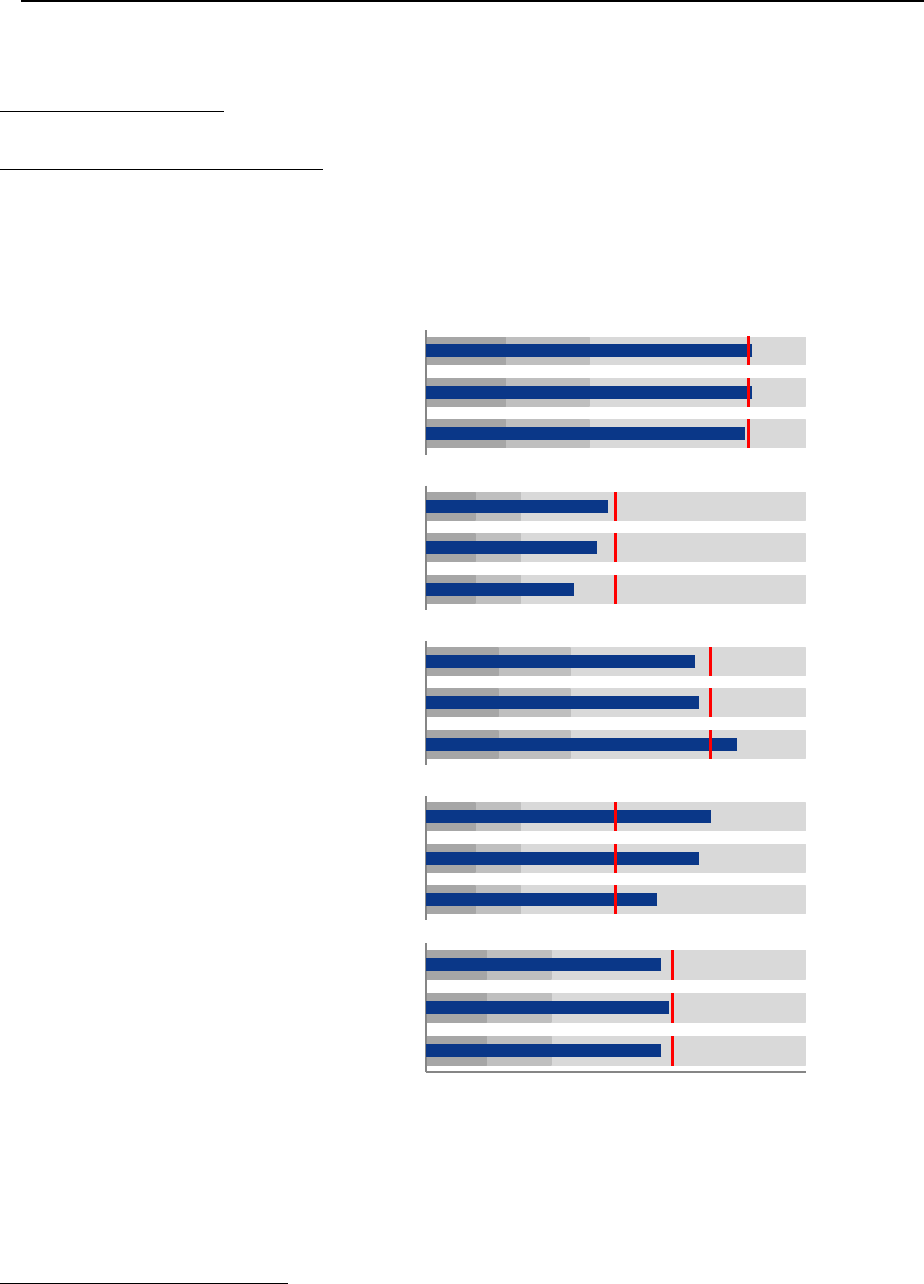
NATIONAL DRUG CONTROL STRATEGY: FY 2022 BUDGET AND PERFORMANCE SUMMARY
46
PERFORMANCE
Community Supervision Program
Drug testing and treatment are at the core of CSP’s approach to addressing offender needs regarding
illicit substance use, and several performance goals were set forth in CSOSA’s Strategic Plan to address
these items. Figure 1 shows CSP’s progress towards achieving these goals during FYs 2018 through
2020.
5
The blue bars depict progress on the targets for each goal in relation to the red target line.
The shades of gray represent areas of low, medium and high performance.
CSP performance on goals related to drug testing and treatment, FYs 2018–2020.
Overall estimates for these goals include substance use treatment and treatment readiness programs, as well as
programs for other supportive services. Detailed data on the substance use and treatment readiness programs
included in each goal are displayed in Appendix A.
5
Additional metrics for FY 2018–2022 are under development and being tested to ensure accuracy and are expected to be
ready for reporting in our upcoming performance year.
FY 2018 (n=43,148)
FY 2019 (n=42,595)
FY 2020 (n=21,282)
Regular Drug
Testingͣ
FY 2018 (n=11,630)
FY 2019 (n=10,079)
FY 2020 (n=6,837)
Timely Evaluation
FY 2018 (n=7,756)
FY 2019 (n=5,496)
FY 2020 (n=2,964)
Risk Principle
FY 2018 (n=4,136)
FY 2019 (n=3,504)
FY 2020 (n=1,922)
Timely Placement
0 50 100
FY 2018 (n=2,623)
FY 2019 (n=2,386)
FY 2020 (n=1,419)
Successful
Treatment
Completion

NATIONAL DRUG CONTROL STRATEGY: FY 2022 BUDGET AND PERFORMANCE SUMMARY
47
ª Performance is reflected through the second quarter of FY 2020 since drug testing operations were suspended in
March 2020 amid the COVID-19 pandemic
Many CSP offenders are a high risk to public safety, have significant needs, and face many challenges
to successfully completing supervision. Among these challenges is illicit substance use. In FY 2020,
approximately 85 percent of the offenders beginning CSP supervision self-reported a history of illicit
substance use.
CSP monitors offenders’ compliance with the releasing authorities’ requirements to abstain from drug
use and assesses the offenders’ needs for substance use treatment. CSP policy also defines the
schedule under which eligible offenders are drug-tested. Offenders can become ineligible for testing
(other than initial testing at intake) for a variety of administrative reasons, including a change from
active to monitored or warrant status, case transfer from DC to another jurisdiction, rearrests, and
admission to substance abuse treatment. The policy includes spot testing for offenders who are on
minimum supervision, as well as those who do not have histories of drug use and have established a
record of negative tests.
CSP temporarily suspended offender drug testing in March 2020 due to the COVID-19 pandemic. Prior
to the temporary suspension, CSP tested samples from 4,034 unique offenders in March 2020. When
drug testing operations resumed in August 2020, testing was limited to only the highest-risk offenders.
Of the 442 offenders tested for illicit substances in September 2020, 50 percent tested positive for one
or more of 11 tested substances.
6
CSP places certain substance abusing offenders into treatment on a risk-based, priority basis. In
addition to offering a variety of in-house and outpatient services, CSOSA’s Re-entry and Sanctions
Center (RSC) provides high-risk offenders and pretrial defendants with an intensive assessment and
treatment readiness program (28 days for men; 42 days for women) in a residential setting. It is
particularly suited for offenders/defendants with persistent substance abuse, long periods of
incarceration and little outside support.
Due to limited resources, CSP attempts to focus its programs on the offenders who have the highest
needs and present the highest risks. In FY 2020, despite challenges and constraints placed on resources
amid the COVID-19 pandemic, CSP ensured that available resources were reserved for those at the
highest risk to public safety. Seventy-eight percent of substance abuse treatment and treatment
readiness placements were made for offenders supervised at the highest risk levels (maximum and
intensive; see Appendix A, Figure 2, Risk Principle).
Once offenders are referred for substance abuse treatment or treatment readiness by their community
supervision officers, they are evaluated by treatment staff to determine whether programming [or
placement] is appropriate. If deemed appropriate for intervention, it is imperative that offenders are
placed in treatment and support services in a timely manner. Two performance goals are used to
monitor the timeliness in which evaluations and treatment placements occur. In FY 2020, 49 percent of
offenders referred to substance abuse treatment or treatment readiness programs received a formal
evaluation of need in a timely manner, and 66 percent of treatment placements were made in a timely
6
PSA tests samples obtained by CSP from offenders. Each sample may be tested for up to eleven substances [Marijuana, PCP,
Opiates, Methadone, Cocaine, Amphetamines, Alcohol, Creatinine, Heroin, Etg, and Synthetic Cannabinoids].

NATIONAL DRUG CONTROL STRATEGY: FY 2022 BUDGET AND PERFORMANCE SUMMARY
48
fashion (see Appendix A, Figure 2, Timely Evaluation and Timely Placement). It is expected that the
COVID-19 pandemic impacted CSP’s performance, as staff adjusted to new techniques using tools to
conduct virtual evaluations and dealt with the uncertainty of available resources. CSP has been
working through these challenges so we can best serve our population and ensure they have access to
the resources they need.
CSP also monitors offenders’ completion of treatment. Sixty percent of the offenders who started
substance abuse treatment or treatment readiness programs satisfactorily completed their programs
during FY 2020 (see Appendix A, Figure 2, Successful Treatment Completion). Of the high-risk offenders
who were discharged from the RSC in FY 2020, 64 percent satisfactorily completed the program
7
(see
Appendix A, Figure 2, Successful Treatment Completion). Relatively low treatment completion rates for
offenders participating in transitional housing and, to a lesser extent, aftercare and outpatient
treatment contributed to CSP not meeting its FY 2020 performance target (see Appendix A, Figure 2,
Successful Treatment Completion [SA Tx modality]).
CSP is committed to making evidence-based decisions regarding its programs. CSP monitors the needs
of its offender population to ensure programming is available to address those needs. In addition to
substance abuse, many offenders present with mental health and cognitive disorders. As a result, in FY
2019, CSOSA deployed a new Extended Stay unit to provide longer-term support to defendants and
offenders. And, in FY 2020, continued to restructure the RSC from a treatment-readiness program to a
treatment program in FY 2020. Specifically, RSC services were expanded to include additional cognitive
behavioral therapy and interventions for our highest risk offenders. While RSC operations were
suspended in March 2020 as a result of the COVID-19 pandemic, CSP placed applicable offenders into
contract residential treatment and/or increased supervision oversight. CSOSA expects to resume
programming at the RSC once it is safe to do so.
Pretrial Services Agency
One of PSA’s strategic objectives is to reduce drug usage among the defendants placed in treatment.
Due to COVID-19, in March 2020, placement into SUD treatment was suspended. Although substance
use disorder treatment placement is voluntary, PSA placed 33 percent of eligible defendants in
treatment in FY 2020. Among defendants placed in a sanction-based treatment program, 85 percent
had a reduction in drug use (PSA Table 2).
7
Pretrial defendants excluded from reporting

NATIONAL DRUG CONTROL STRATEGY: FY 2022 BUDGET AND PERFORMANCE SUMMARY
49
PSA Table 2
Pretrial Services Agency
Drug-Related
Agency
Performance
Indicators
FY
2016
Actual
FY
2017
Actual
FY 2018
Actual
FY 2019
Actual
FY 2020
Actual
4
FY 2018-2022
Target
»
Strategic
Objective
3.2.1:
SUD
Assessments
92%
93%
91%
96%
95%
95%
»
Strategic
Objective
3.2.2:
Placement
into SUD
Treatment
49%
53%
55%
50%
33%
50%
»
Strategic
Objective
3.2.3:
Reduction in
Drug Use
84%
85%
82%
85%
85%
74%
`*Due to COVID-19 and the interruption in PSA’s normal operations, data covers October 2019 through March
2020.
Fifty-five defendants successfully graduated from the Drug Court Program and had the charge against
them withdrawn by the prosecuting authority, or they received a favorable sentencing outcome from
the Drug Court Judge, in exchange for their successful completion of the program.
8
During the program,
participants have immediate access to SUD treatment and receive specialized care, including gender-
specific groups and individual and group therapy for trauma-impacted individuals.
FY 2020 Accomplishment Highlights
1. Implemented Universal Fentanyl Testing
In response to the nationwide public health emergency to address the opioid crisis and based
on PSA’s research findings showing fentanyl use among its defendant population, PSA
expanded its substance use testing panel to include fentanyl testing. While COVID-19 delayed
the PSA’s originally scheduled plans to begin fentanyl testing in April 2020, PSA is ready to
implement universal fentanyl screening upon the PSA’s return to normal operations.
8
Due to COVID-19 and the interruption of PSA’s normal operations, data covers October 2019 through March 2020.

NATIONAL DRUG CONTROL STRATEGY: FY 2022 BUDGET AND PERFORMANCE SUMMARY
50
2. Reduced Turnaround Times for Oral Fluid Screening
Due to medical conditions and other factors, some defendants and respondents are unable to
provide urine specimens for testing. As an alternative for these individuals, PSA conducts oral
fluid testing.
From the inception of the PSA’s oral fluid testing program, PSA relied upon the services of an
external contractor for the screening and confirmation testing of its oral fluid specimens. Use
of the external contractor caused delays in the turnaround times for specimen results and
resulted in increased testing expenses for the agency. To mitigate these issues, in July 2016,
PSA began screening a limited number of oral fluid specimens with the use of in-house manual
analysis and data entry technology. While this new screening method lowered testing expenses
for PSA, delays in turnaround times for specimen results still persisted due to the manual
analysis process.
In February 2020, PSA secured and introduced testing kits that allow for screening of oral fluid
specimens using its high-capacity automated analyzers. The introduction of the new oral fluid
specimen testing kit enabled PSA to reduce testing turnaround times from seven business days
to five business days for routine oral fluid test results, and from four business days to two
business days for spot test results. In addition to reducing turnaround times for oral fluid
screening, the new kit expanded detection to include four additional substances: alcohol,
methadone, methamphetamine, and oxycodone. This new kit enables detection of a total of
nine substances. This includes the newly added substances mentioned above, plus the original
five that were previously detected: amphetamines, cocaine/cocaine metabolites, marijuana,
opiates, and PCP.
APPENDIX A
RSC (n=793)
SA (n=2,947)
SA Tx Subtotal (n=3,740)
Timely Evaluation
RSC (n=515)
SA (n=1,363)
SA Tx Subtotal (n=1,471)
Risk Principle

NATIONAL DRUG CONTROL STRATEGY: FY 2022 BUDGET AND PERFORMANCE SUMMARY
51
Figure 2. CSP performance on goals related to drug testing and treatment, by treatment type and drug treatment modality,
FY 2020.
RSC (n=583)
SA (n=873)
CIT Staffing (n=35)
SA Tx Subtotal (n=1,491)
Timely Placement
RSC (n=332)
SA (n=778)
SA Tx Subtotal (n=1,110)
Successful
Treatment
Completion
0 50 100
Detox (n=31)
Residential (n=61)
ST Residential (n=196)
Outpatient (n=309)
Aftercare (n=7)
Transitional (n=174)
Successful
Treatment
Completion
[SA Tx Modality]

NATIONAL DRUG CONTROL STRATEGY: FY 2022 BUDGET AND PERFORMANCE SUMMARY
52
DEPARTMENT OF DEFENSE

NATIONAL DRUG CONTROL STRATEGY: FY 2022 BUDGET AND PERFORMANCE SUMMARY
53
DEPARTMENT OF DEFENSE
Office of the Secretary of Defense
Resource Summary
Budget Authority (in millions)
FY 2020
Final
FY 2021
Enacted
FY 2022
Request
Drug Resources by Function
Intelligence
$178.931
$193.542
$227.233
Interdiction
4,298.373
437.155
420.053
International
81.481
22.075
33.379
Prevention
124.922
127.704
126.024
State and Local Assistance
223.822
229.833
113.017
Total Drug Resources by Function
$4,907.529
$1,010.309
$919.706
Drug Resources by Decision Unit
Drug Interdiction and Counterdrug Activities
1
$4,719.059
$914.429
$821.908
Overseas Contingency Operations (OCO)
2
84.743
---
---
Operations Tempo (OPTEMPO)
103.727
95.880
97.798
Total Drug Resources by Decision Unit
$ 4,907.529
$1,010.309
$919.706
Drug Resources Personnel Summary
Total Full Time Equivalent (FTE) positions
1,528
1,528
1,528
Drug Resources as a percent of Budget
Total Agency Budget (in Billions)
$ 723.2
$ 703.7
$ 715.0
Drug Resources percentage
0.7 %
0.1 %
0.1 %
1
FY 2020 includes $3,831 million reprogrammed from other DOD programs for barrier construction to block the smuggling
corridors along the U.S. southern border in support of DHS under 10 USC §284(b)(7).
2
Since FY 2021, funding to support enduring OCO requirements has been budgeted within DOD’s base budget.
Program Summary
MISSION
The Drug Interdiction and CD Activities appropriation funds DoD programs and activities to support the
continuing national priority to identify, interdict, disrupt, and dismantle those transnational criminal
networks that pose the greatest threats to United States national security by targeting infrastructure,
depriving them of enabling means, and preventing the criminal facilitation of terrorist activities and the
malign activities of adversary states. The appropriation also supports DoD drug demand reduction
(DDR) programs to promote and maintain a drug-free military and civilian workforce and work
environment.
The threat to United States national security posed by illicit drugs extends beyond traditional
challenges and directly impacts public health and safety. Many of our Nation's adversaries, including
nation-states, non-state actors, and violent extremist organizations (VEO), depend on proceeds

NATIONAL DRUG CONTROL STRATEGY: FY 2022 BUDGET AND PERFORMANCE SUMMARY
54
generated from drug trafficking and other illicit activities to fund their operations. Some state and non-
state adversaries influence, oversee, or directly control criminal enterprises. The task of identifying and
targeting drug trafficking and other illicit threat networks is complex and requires close coordination
among United States and international military, intelligence, and law enforcement partners. While
sustaining its global CD efforts, DoD is directing operational and fiscal resources toward efforts that
support National Defense Strategy objectives to disrupt, degrade, and dismantle threat networks and
VEO that use proceeds generated from illicit activities to fuel insurgencies, contribute to regional
instability, or support acts of terrorism.
The Department’s statutory mission to detect and monitor aerial and maritime transit of illicit drugs
toward the United States remains a priority. By performing this mission, DoD helps deter, disrupt, and
defeat potential threats before they reach the United States. This includes supporting interagency and
international efforts to target TCOs at their source, and building international partnerships to prevent
transnational threat networks from undermining sovereign governments and decreasing regional
stability.
METHODOLOGY
The DoD Drug Interdiction and Counterdrug Activities budget is drug-related, and is therefore scored as
a part of the National Drug Control Budget. Funds are programmed and budgeted for specific projects
and activities, and then transferred during the fiscal year of execution to the most appropriate Military
Service or Defense Agency for implementation. Operations Tempo (OPTEMPO) estimates are computed
by the Services to support CD efforts, either by aircraft hours or ship days, and are reported by the
Services to the office of the Deputy Assistant Secretary of Defense for Counternarcotics and Global
Threats [DASD(CN>)].
BUDGET SUMMARY
For FY 2022, DoD requests $821.9 million for drug control activities, a net decrease of $92.5 million from
the FY 2021 enacted level.
Drug Interdiction and CD Activities Decision Unit
Total FY 2022 Request: $821.9 million
($92.5 million below the FY 2021 enacted level
)
The FY 2022 request for the Drug Interdiction and CD Activities Decision Unit supports five National Drug
Control Program Functions: Intelligence, Interdiction, International, Prevention, and State and Local
Assistance. The FY 2021-22 net decrease of $92.5 million includes an inflation increase of $22.7 million,
program increases of $33.9 million, and a program decrease of $149.1 to account for one-time FY 2021
congressional enhancements.
Intelligence
FY 2022 Request: $227.2 million
($33.7 million above the FY 2021 enacted level)
DoD support of the Intelligence Drug Control Function includes funding for classified and sensitive
unclassified intelligence and related technology programs to collect, process, analyze, and disseminate
strategic, operational, and tactical intelligence and information required for combatant command and
interagency CD and related counter transnational organized crime (CTOC) operations and activities.
The interdiction intelligence functions of Joint Interagency Task Force–South (JIATF-S) and Joint

NATIONAL DRUG CONTROL STRATEGY: FY 2022 BUDGET AND PERFORMANCE SUMMARY
55
Interagency Task Force–West (JIATF-W) also support this drug control function. The FY 2021-22
increase of $33.7 million includes a $4.5 million inflation increase and a program increase of $29.2
million.
Interdiction
FY 2022 Request: $322.3 million
($19.0 million below the FY 2021 enacted level)
Pursuant to Title 10, U.S. Code §124, DoD support of the Interdiction Drug Control Function includes
funding for programs to detect and monitor the aerial and maritime transit of illegal drugs toward the
United States in support of U.S. and Partner Nation (PN) law enforcement interdiction operations.
Funding for this function supports logistics and base operations support for maritime patrol,
reconnaissance, and aerial tanker aircraft, to include operations from multiple forward operating
locations; contracted operations and maintenance in support of DoD owned maritime patrol aircraft
(MPA); multi-mission support vessel operations; multi-site Relocatable Over-The-Horizon Radar (OTH)
system operations; and support for command and control centers, including the operations functions
of JIATF-S. The FY 2021-22 net decrease of $19.0 million includes a $8.7 million inflation increase and a
program decrease of $27.7 million.
International
FY 2022 Request: $33.4 million
($11.3 million above the FY 2021 enacted level)
Most DoD activities that support the International Drug Control Function are executed under Title 10,
U.S. Code, Chapter 15 §284. Funding for this function supports CD and CD-related CTOC efforts within
the six geographic Combatant Commands’ Areas of Responsibility to detect, interdict, disrupt, or curtail
activities related to substances, material, weapons or resources used to finance, support, secure,
cultivate, process or transport illegal drugs. Activities include transportation support, PN D&M, and
intelligence analysis in support of United States and international LEAs designed to complement DoD
security cooperation efforts. The FY 2021-22 net increase of $11.3 million includes an inflation increase
of $0.5 million and program increases of $10.8 million.
Prevention
FY 2022 Request: $126.0 million
($1.7 million below the FY 2021 enacted level)
DoD DDR efforts support the Prevention Drug Control Function and finance programs to detect and
deter the misuse of illicit and prescription drugs among military and civilian personnel. Funding
supports drug testing specimen collection, drug testing laboratories, and associated analysis costs and
finances military service, National Guard, and defense agency outreach, prevention, and education
programs. These funds support a minimum of 100% random drug testing for active duty military,
National Guard and Reserve personnel; drug testing for all DoD civilian employee applicants and
civilians in testing designated positions once every two years; and drug abuse prevention and
education activities for military and civilian personnel and their dependents. The FY 2021-22 net
decrease of $1.7 million from the FY 2021 enacted level includes an inflation increase of $2.8 million, a
decrease of $4.1 million to account for a one-time FY 2021 congressional enhancement, and a program
decrease of $0.4 million.

NATIONAL DRUG CONTROL STRATEGY: FY 2022 BUDGET AND PERFORMANCE SUMMARY
56
State and Local Assistance
FY 2022 Request: $113.0 million
($116.8 million below the FY 2021 enacted level)
DoD programs executed under the State and Local Assistance Drug Control Function support federal,
state and local drug law enforcement agency (DLEA) requests at the state and community level in efforts
to reduce drug-related crime. Under Title 32 U.S. Code, §112, this activity funds National Guard support
for domestic law enforcement under the Governors’ State Plans and CD Schools programs. The FY 2021-
22 net decrease of $116.8 million includes an inflation increase of $6.2 million, a program decrease of
$123.2 to account for one-time FY 2021 congressional enhancements, and a program increase of $0.2
million.
Operations Tempo
FY 2022 Request: $97.8 million
($1.9 million above the FY 2021 enacted level)
The OPTEMPO Decision Unit supports the Interdiction Drug Control Function and estimates the level of
funding for DoD aircraft flight hours and ship steaming days that support CD activities. The military
services derive these estimates by multiplying the aircraft cost per flight hour/ship steam days by the
number of hours/days the system is employed in supporting CD missions and activities. Estimates may
include transit time, on-station time, and training. The FY 2021-22 increase from the FY 2021 enacted
level reflects an inflation increase of $1.9 million.
PERFORMANCE
DoD delivers global support to the nation’s CD and CTOC efforts via programs focused on the D&M of
aerial and maritime drug threats bound for the United States, by supporting U.S. and international
partner operations and information sharing, conducting global intelligence and counter threat finance
analyses, and by encouraging a drug-free workplace through drug demand reduction and prevention
programs.
Measures of performance assigned to these activities are used by decision makers to measure actual
results for comparison to annual goals and progress toward strategic objectives; guide the allocation
of budgetary resources during the annual planning, programming, budgeting, and execution process;
provide management and oversight of DoD CD and CTOC programs; and facilitate communications and
engagements with internal and external stakeholders. Selected examples of FY 2021 qualitative and
quantitative program performance results are provided in the following table and accompanying
narrative to communicate DoD’s progress toward achieving operational objectives in support of the
National Drug Control Program.

NATIONAL DRUG CONTROL STRATEGY: FY 2022 BUDGET AND PERFORMANCE SUMMARY
57
Office of the Secretary of Defense
Selected Measures of Performance
FY 2020
Target
FY 2020
Achieved
Budget Decision Unit 1 – Drug Interdiction and Counterdrug Activities
»
Percentage of detected events successfully handed-off to interdiction and
apprehension resources (JIATF-S)
80 %
68 %
»
DoD military personnel testing positive for drug use
< 2 %
0.87 %
»
DoD civilian personnel testing positive for drug use
< 1 %
0.40 %
»
Heroin removal by Combined Task Force-150 (CTF-150) in the Indian Ocean Transit
Zone
4,800 kg
4,054 kg
Budget Decision Unit 2 – Counterdrug Operations Tempo
»
Aircraft and ship OPTEMPO hours executed by the U.S. Armed Forces in support of
global counterdrug operations
28,556
42,351
Budget Decision Unit 1: Drug Interdiction and Counterdrug Activities
Measure 1: Percentage of total global illicit-trafficking events, as estimated by interagency and
international intelligence activities, detected and successfully handed-off to interdiction and
apprehension assets by JIATF-S.
This measure is the primary gauge for assessing the Department’s performance as the single lead
agency of the federal Government for detecting and monitoring aerial and maritime transit of illicit
drugs into the United States through the Western Hemisphere Transit Zone (WHTZ). The WHTZ includes
the Caribbean Sea, the Gulf of Mexico, and the eastern Pacific Ocean. U.S. Southern Command’s
(USOUTHCOM) JIATF-S facilitates drug interdiction by leveraging cued intelligence and other sources.
The task force detects, monitors, and then hands-off potential targets to U.S. and international law
enforcement agencies that possess the authorities to conduct subsequent interdiction and
apprehension (I&A).
In FY 2020, JIATF-S logged 8,454 Critical Movement Alerts (CMAs) comprised of initial intelligence
submissions, of which 7,481 were Drug Movement Alerts (DMAs), a subset of CMAs that capture an
impending or ongoing illicit-drug movement. During quarterly Consolidated Counterdrug Data Base
(CCDB) vetting sessions, each interagency partner-submitted event was examined to ensure strict
adherence to agreed-upon criteria. This refinement process resulted in the designation of 2,658
validated JIATF-S maritime events for FY 2020. Of the 2,658 JIATF-S CCDB maritime events, JIATF-S was
able to target 853 (32%). Target in this context, is the act of trying to locate an illicit conveyance with
resources such as, aircraft, ships, helicopters, etc. Of the 853 targeted events, 278 (33%) were detected
by U.S. or PN D&M assets. Of these, 188 were successfully handed-off to U.S. or PN law enforcement I&A
assets. This resulted in a 68% success rate for disruptions once the illicit target was detected, falling
short of the 80% target.
The 80% FY 2020 target was set as an incremental increase towards a goal of 100% (the target is
reviewed on an annual basis). Many variables affect the hand-off success percentage, but each year
U.S. and PNs strive to become more efficient and effective by increasing capabilities, capacities, and
competencies with assets/resources, command and control, information sharing, and technological
advancements to enable better detection to hand-off successes.

NATIONAL DRUG CONTROL STRATEGY: FY 2022 BUDGET AND PERFORMANCE SUMMARY
58
JIATF-S serves as a critical force multiplier for U.S. law enforcement agencies for evidence collection,
grand jury proceedings, indictments, and extraditions leading to the interdiction or arrest of key drug
trafficking organization members, Consolidated Priority Organization Targets (CPOT), and the
disruption of prioritized transnational threat networks. Below is a summary of FY 2020 law enforcement
statistics for drug seizures where JIATF-S provided assistance as compared to FY 2019:
• Arrests/Detainees: 707, decreased by 5%
• Conveyances (vessels and aircraft): 200, decreased by 12%
• Cocaine: 255.8 metric tons, decreased by 9% (estimated $6.6B loss to traffickers)
• Marijuana: 39 metric tons, increased by 63% (estimated $429M loss to traffickers)
Measures 2 and 3: DoD military and civilian personnel testing positive for drug use.
This measure provides a direct and effective indication of unauthorized drug use by U.S. Armed Service
members and DoD civilian employees. As drug use is incompatible with DoD military and public service,
the DoD Drug Demand Reduction Program was mandated in 1981 with the mission to deter DoD
personnel from abusing illicit drugs or misusing prescription drugs. Program components include
compulsory random drug testing with punitive consequences and anti-drug education and outreach
programs. DoD is on track to keep the illicit-drug positive rate below 2% for military personnel and
below 1% for civilian personnel, despite the Department recently expanding the drug testing panel to
include commonly-abused prescription drugs and synthetic marijuana (a.k.a. Spice).
Measure 4: Indian Ocean Heroin Removal by Combined Task Force-150
This is an outcome indicator of maritime operations conducted by Combined Task Force-150 (CTF-150)
in the Indian Ocean that were cued to targets by the Regional Narcotics Interagency Fusion Cell (RNIFC).
Co-located with U.S. Naval Forces Central Command in Bahrain, RNIFC analyzes, fuses, develops and
disseminates intelligence and law enforcement information to assist in the targeting of narcotics
trafficking, transnational criminal organization networks, and other transnational threats.
In FY 2020, the RNIFC provided information and Contacts of Interests (CoI) to regional law enforcement
partners and CTF-150 that resulted in 8 Indian Ocean maritime narcotics seizures. Approximately 4,054
kilograms of heroin were confiscated, exploited for intelligence, and destroyed. In addition to heroin,
CTF-150 ships confiscated and destroyed approximately 13,832 kg of hashish, 2,620.8 kg of
methamphetamines, 62 kg of cocaine and 579 kg of other narcotics substances.
Budget Decision Unit 2: Counterdrug Operations Tempo (OPTEMPO)
Measure 1:
This measure supports the analysis of operational trends by tracking multiyear U.S. Armed Forces CD
OPTEMPO hours in support of U.S. and PN law enforcement CD operations. In FY 2018, DASD CN>
began coordinating with the Military Services to report data for aircraft flight and ship steaming hours
in support of global CD operations to assist ONDCP in obtaining a more complete accounting of total
DoD OPTEMPO provided in support of National Drug Control Strategy goals.

NATIONAL DRUG CONTROL STRATEGY: FY 2022 BUDGET AND PERFORMANCE SUMMARY
59
In FY 2020, combined CD OPTEMPO hours exceeded the annual target by more than 48%. Military ship
steaming hours exceeded the annual target by more than 400%. The OPTEMPO increases were
primarily the result of an April 6, 2020, order by the President and Secretary of Defense to increase DoD
aerial and maritime assets in the USSOUTHCOM Area of Responsibility to support enhanced CD
operations in the Latin America/Caribbean region.
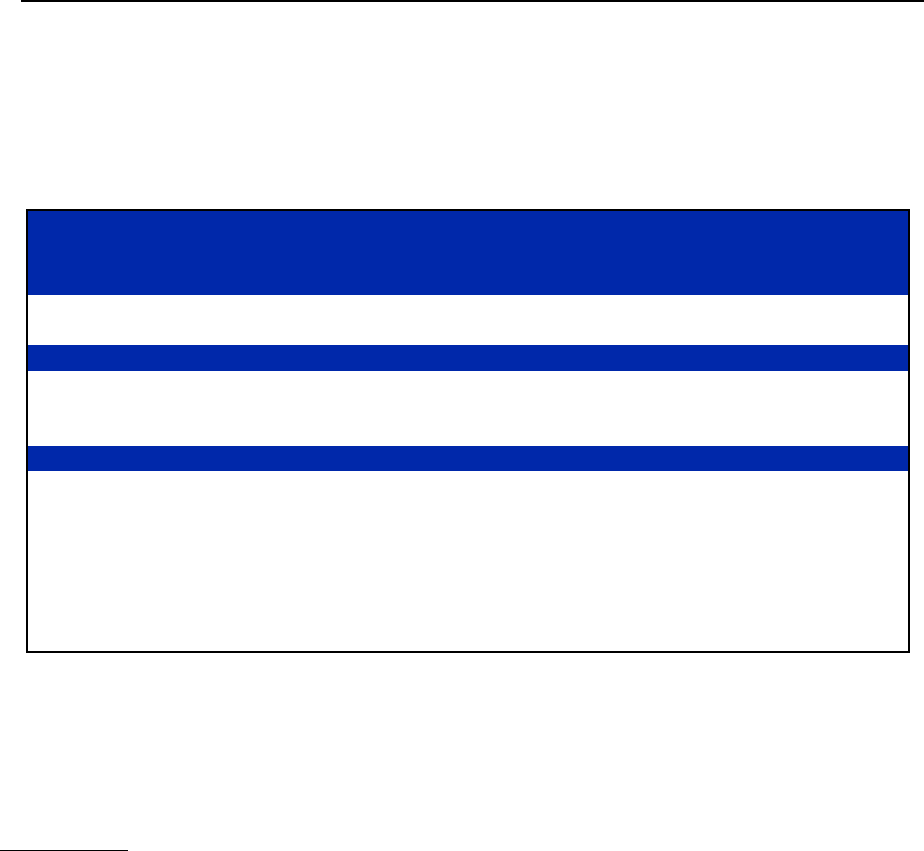
NATIONAL DRUG CONTROL STRATEGY: FY 2022 BUDGET AND PERFORMANCE SUMMARY
60
DEPARTMENT OF DEFENSE
Defense Security Cooperation Agency
Resource Summary
Budget Authority (in Millions)
FY 2020
Enacted
FY 2021
Enacted
FY 2022
Request
Drug Resources by Function
International
$132.264
$54.897
$47.515
Total Drug Resources by Function
$132.264
$54.897
$47.515
Drug Resources by Decision Unit
Building Partner Capacity
$127.295
$49.980
$42.500
4
Regional Center CTOC
4.969
4.917
5.015
Total Drug Resources by Decision Unit
$132.264
$54.897
$47.515
Drug Resources Personnel Summary
Total FTEs (direct only)
11
2
11
11
Drug Resources as a Percent of Budget
Total Agency Budget (in Billions)
$2.1
$2.2
$2.1
Drug Resources Percentage
6%
3
3%
3
2%
Program Summary
MISSION
The Defense Security Cooperation Agency’s (DSCA) mission is to advance U.S. national security and
foreign policy interests by building the capacity of foreign security forces to respond to shared
challenges. DSCA leads the broader U.S. security cooperation enterprise in its efforts to train, educate,
advise, and equip foreign partners.
The threat to U.S. national security posed by illicit drugs extends beyond traditional challenges and
directly impacts public health, safety and security. Many of our nation's adversaries, including nation-
states, non-state actors, and VEO, depend on proceeds generated from drug trafficking and other illicit
activities to fund their operations. Some state and non-state adversaries influence, oversee, or directly
control criminal enterprises. The tasks of identifying and targeting drug trafficking and other illicit
threat networks are complex and require close coordination among U.S. and international military,
intelligence, law enforcement, and government partners. The DoD is directing operational and fiscal
resources toward efforts that support National Defense Strategy objectives to disrupt, degrade, and
dismantle threat networks and VEO that use proceeds generated from illicit activities to fuel
insurgencies, contribute to regional instability, or support acts of terrorism.
1
Funding from DASD CN>. DSCA funds from FY21. Funds reprogrammed from DASD CN> are in that account and appear as non-add amounts.
2
(##) FTEs at the Regional Center CTOC predominately focused on CN/CTOC activities.
3
Amounts rounded to the nearest one percent.
4
These are now provided via the GCMC as part of core O&M.
5
These are notional figures as the budget has not locked.

NATIONAL DRUG CONTROL STRATEGY: FY 2022 BUDGET AND PERFORMANCE SUMMARY
61
METHODOLOGY
The DSCA reports on two Decision Units: George C. Marshall European Center for Security Studies
(GCMC) funded from the Regional Centers Account and the Security Cooperation Account. The GCMC
receives internally reprogrammed funds while the Security Cooperation Account executes the Office of
the Secretary of Defense’s (OSD) identified CN/Countering Transnational Organized Crime (CTOC)
requirements through the Office of the Deputy Assistant Secretary of Defense for Security Cooperation.
The DSCA Comptroller Division utilizes reports from the official accounting system, to track CN and
CTOC funding activity. This information is captured for the fiscal year and reported annually in October.
The data is pulled from the financial system by the identified accounting details based on the programs
identified as counternarcotic programs.
DSCA CN activities are coded as Project Codes. The Project Code utilized by the GCMC CTOC program is
designated by OSD as a transnational program, and as part of its transnational mandate, it is able to
focus its building partnership capacity (BPC) efforts on a global audience sourced from all Geographical
Combatant Commands (GCC). CN and CD funds for the GCMC CTOC program are used to fund both
Civilian Pay and Non Pay requirements in direct support of CN/CTOC requirements as agreed upon
during the initial year of funding in FY17. No more than 25 percent of CN/CTOC funds may be used for
general overhead support costs and Civilian Pay full time employees (FTEs) must dedicate 75 percent
of their job-related duties toward supporting CN requirements as executed under the central account
for BPC and coded with one of the active project codes below.
DSCA utilizes Budget Activity, Budget Sub-Activity, and Budget Line item to generate a unique project
identifier for program execution. These Project Codes are published in the Defense Finance and
Accounting Services (DFAS) Manual 7097.01 dated 5 November 2019. Below is a list Project Codes used
to execute CN/CTOC in FY 2019.
Project Code
Description
0400004G0444000000000000
CN - SEC 333 Base (1-Year)
0400004G0417000000000000
CN - SEC 333 Base (2-Year)
0400004G0418000000000000
CN - SEC 333 OCO (2-Year)
0400004G04A4000000000000
Regional Center CTOC
BUDGET SUMMARY
For FY 2022, DSCA requests $47.5 million for drug control activities, a net decrease of $7.4 million from
the FY 2021 enacted level.

NATIONAL DRUG CONTROL STRATEGY: FY 2022 BUDGET AND PERFORMANCE SUMMARY
62
Building Partner Capacity
FY 2022 Request: $42.5 million
($7.5 million below the FY 2021 enacted level)
DSCA supports foreign partners by providing Counter-Illicit Drug Trafficking (CIDT), CTOC (to potentially
include maritime and border operations) training and equipment to national-level security forces of
foreign countries for purposes of building capacity of partner nations. This support may include the
provision and sustainment of defense articles, training, defense services, supplies, and small-scale
construction supporting security cooperation programs. The FY 2022 net decrease of $7.382 million
from the FY 2021 level which is not reflective of reduced commitments but a reprioritization of
resources.
Regional Center CTOC
FY 2022 Request: $5.0 million
($0.1 million above the FY 2021 enacted level)
DoD support of the George C. Marshall Center (GCMC) program on CTOC focuses on the national security
threats posed by transnational criminal activities and works to reach the Department’s goals to reduce
illicit drug availability, neutralize threat networks, and strengthen partners. The FY 2022 net increase of
$.01 million from the FY 2021 resourced level includes efforts to modify existing and develop new
programs and activities to execute in a virtual environment, ensuring the GCMC continues to stay
engaged until COVID-19 travel restrictions are lifted.
PERFORMANCE
DSCA uses the measures described below to report on its support for the national drug control program.
